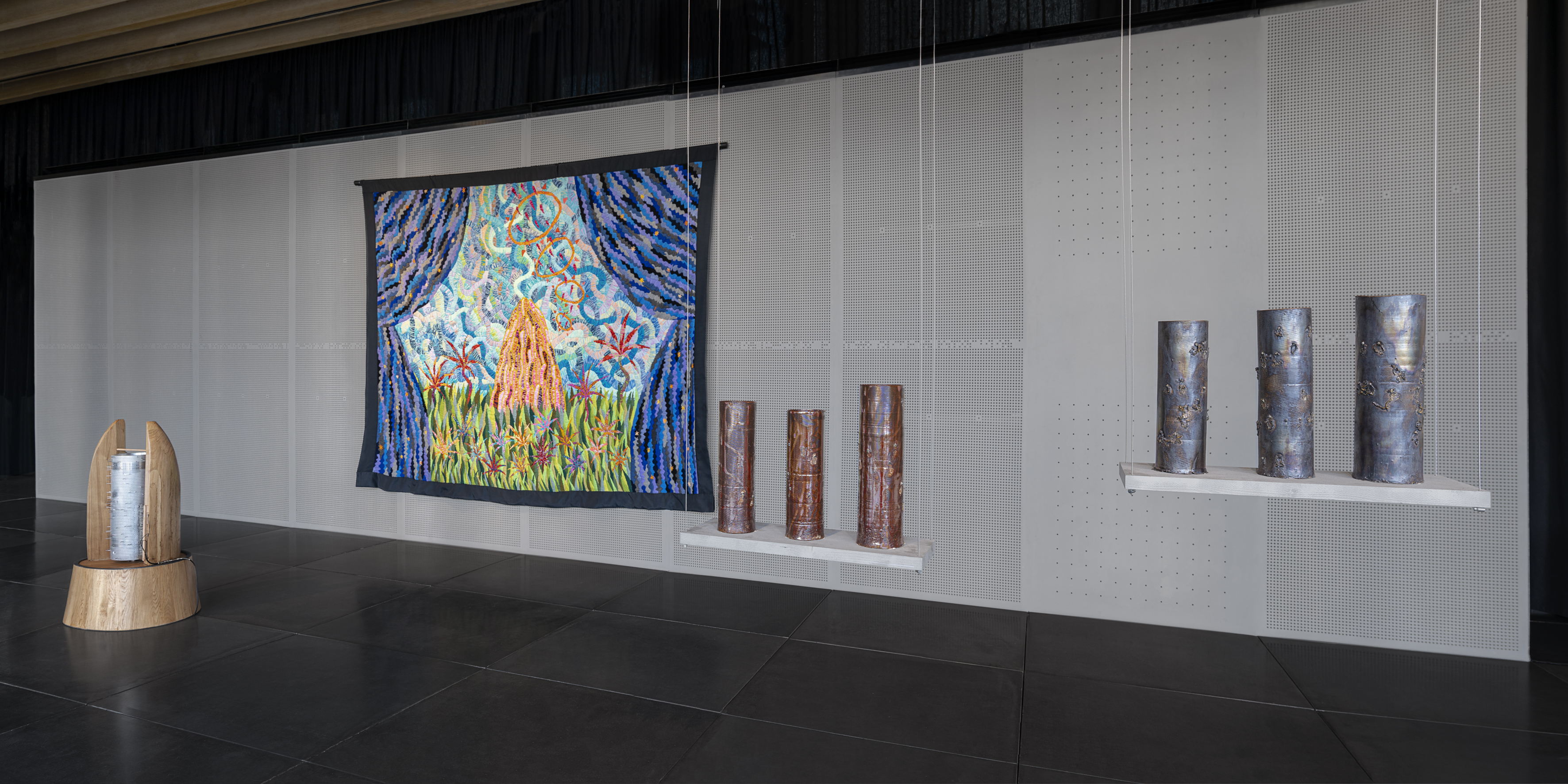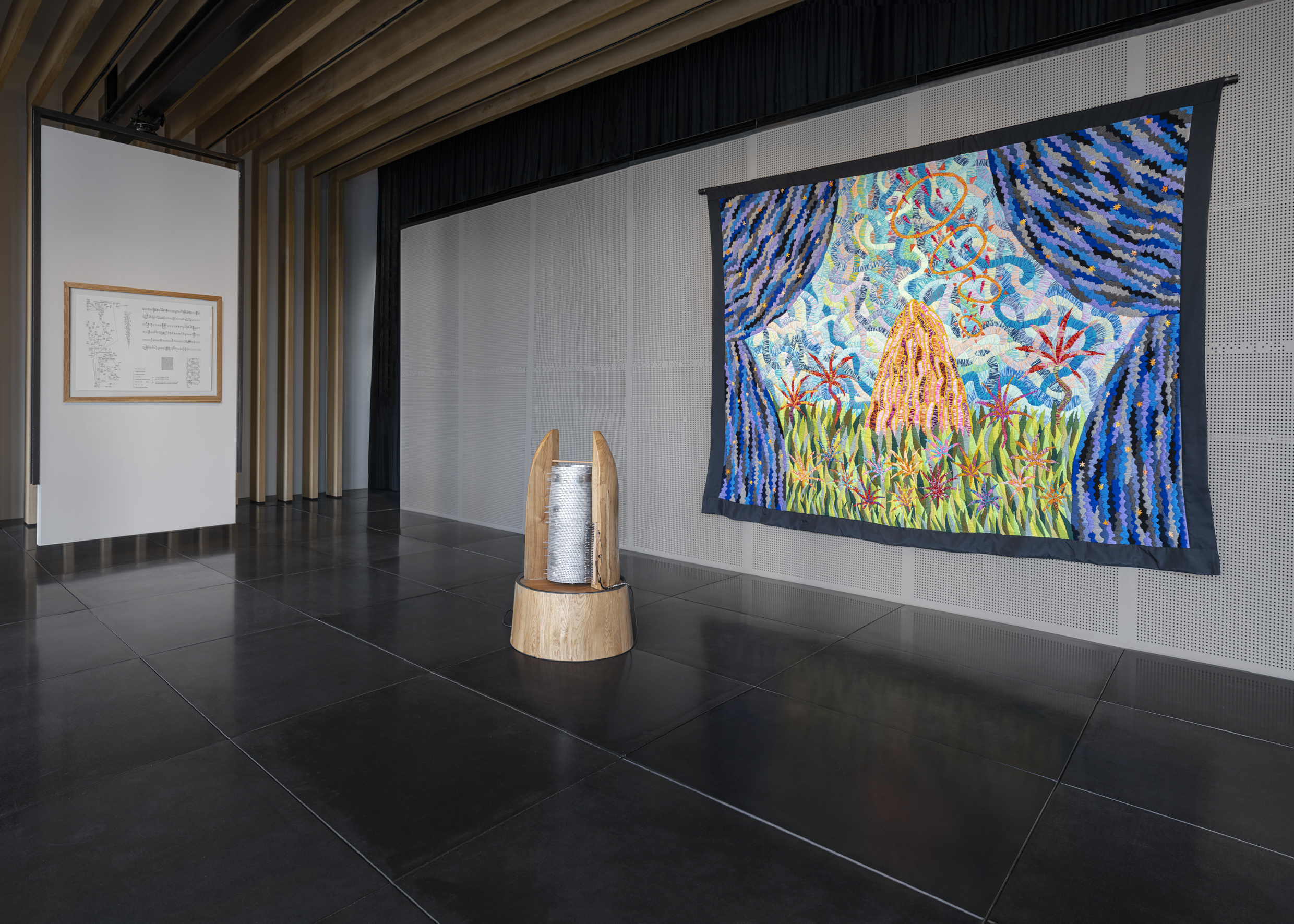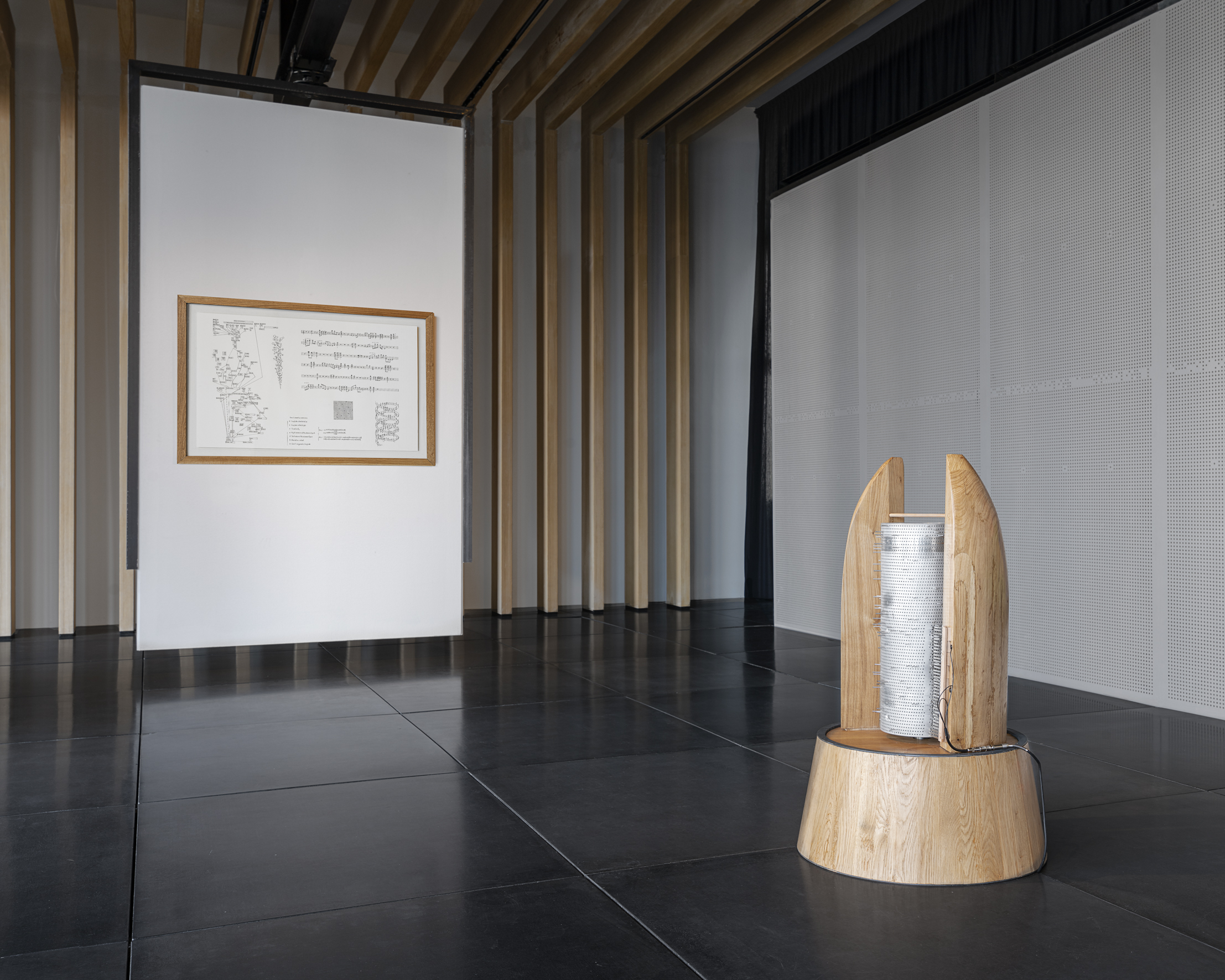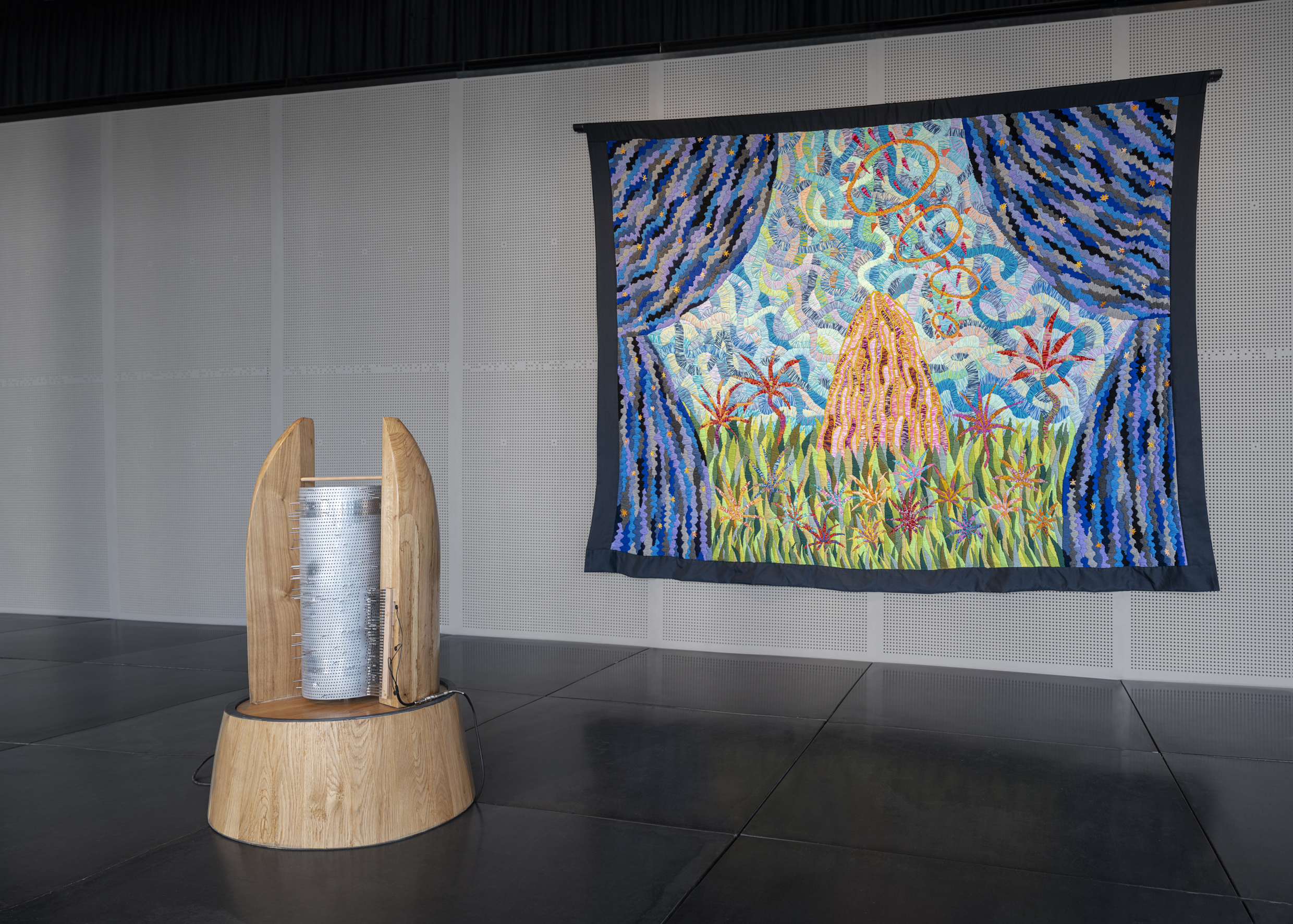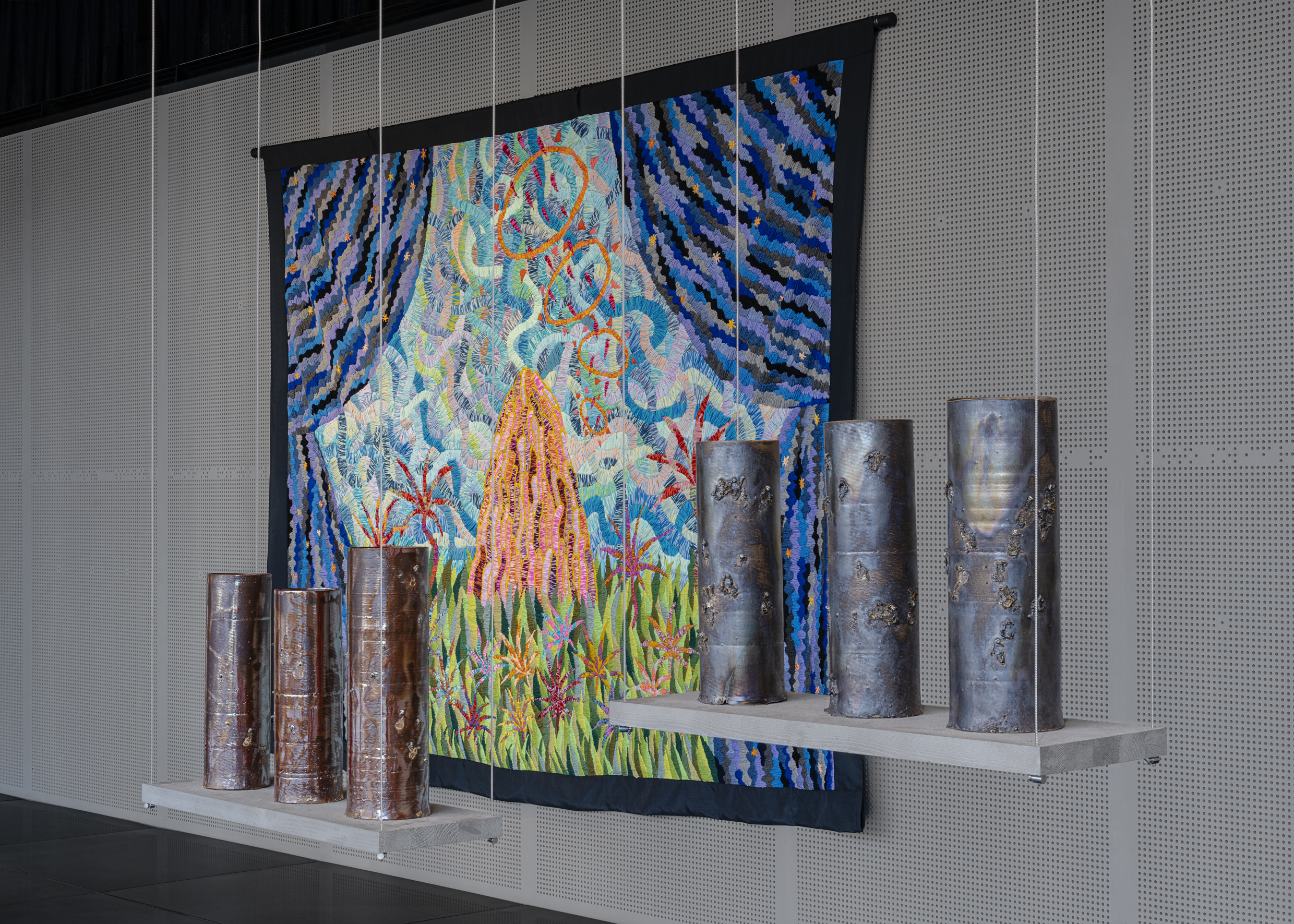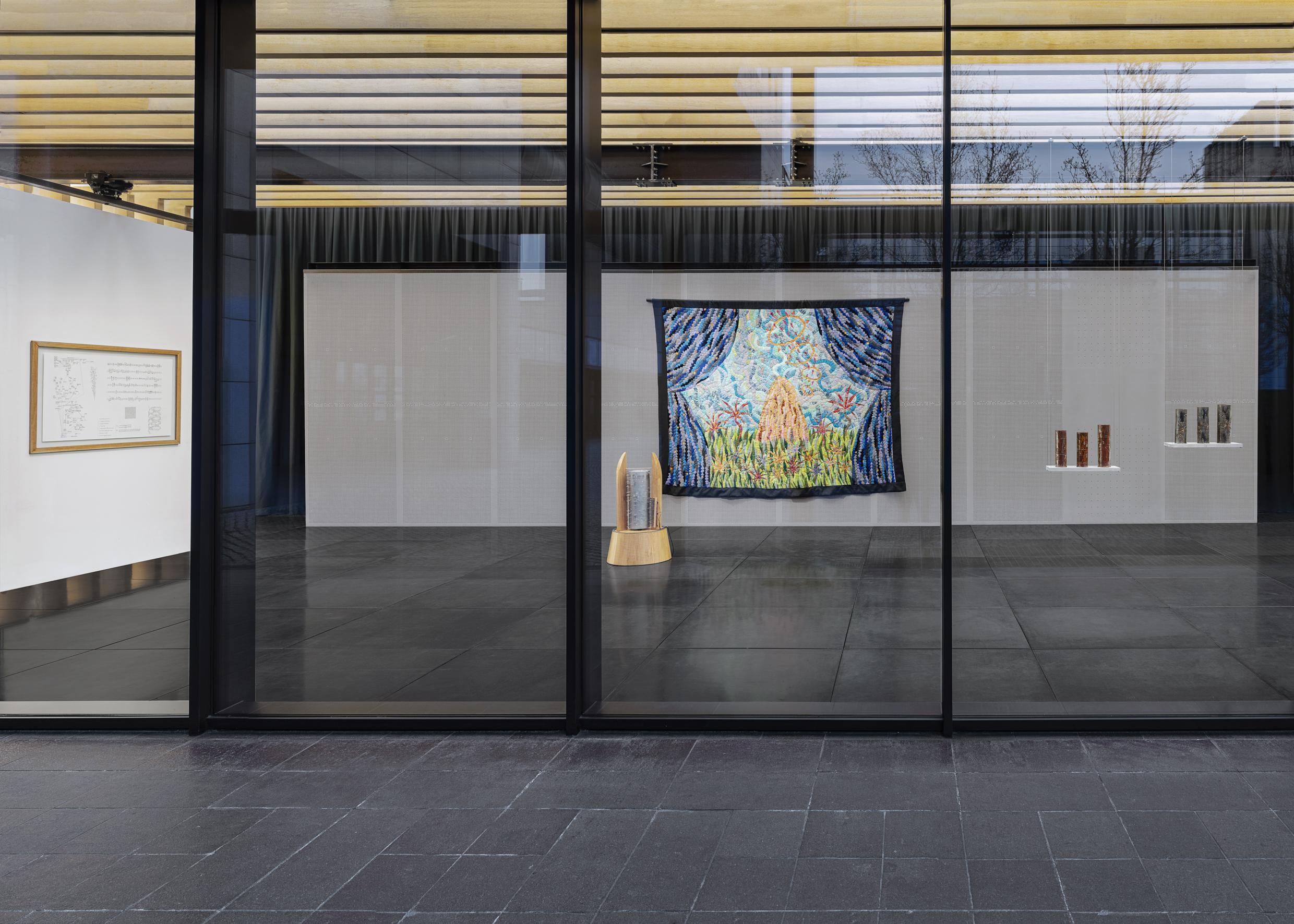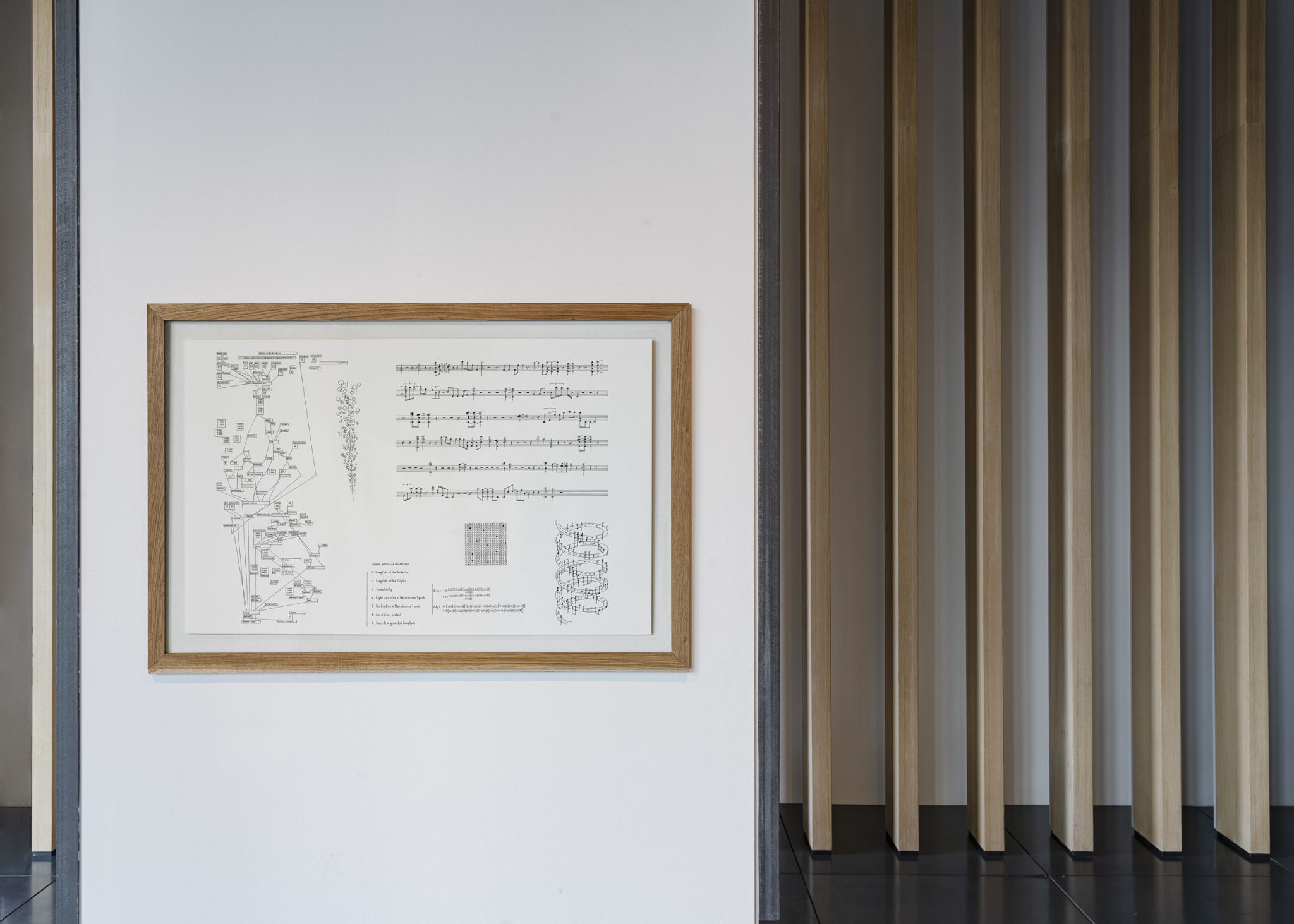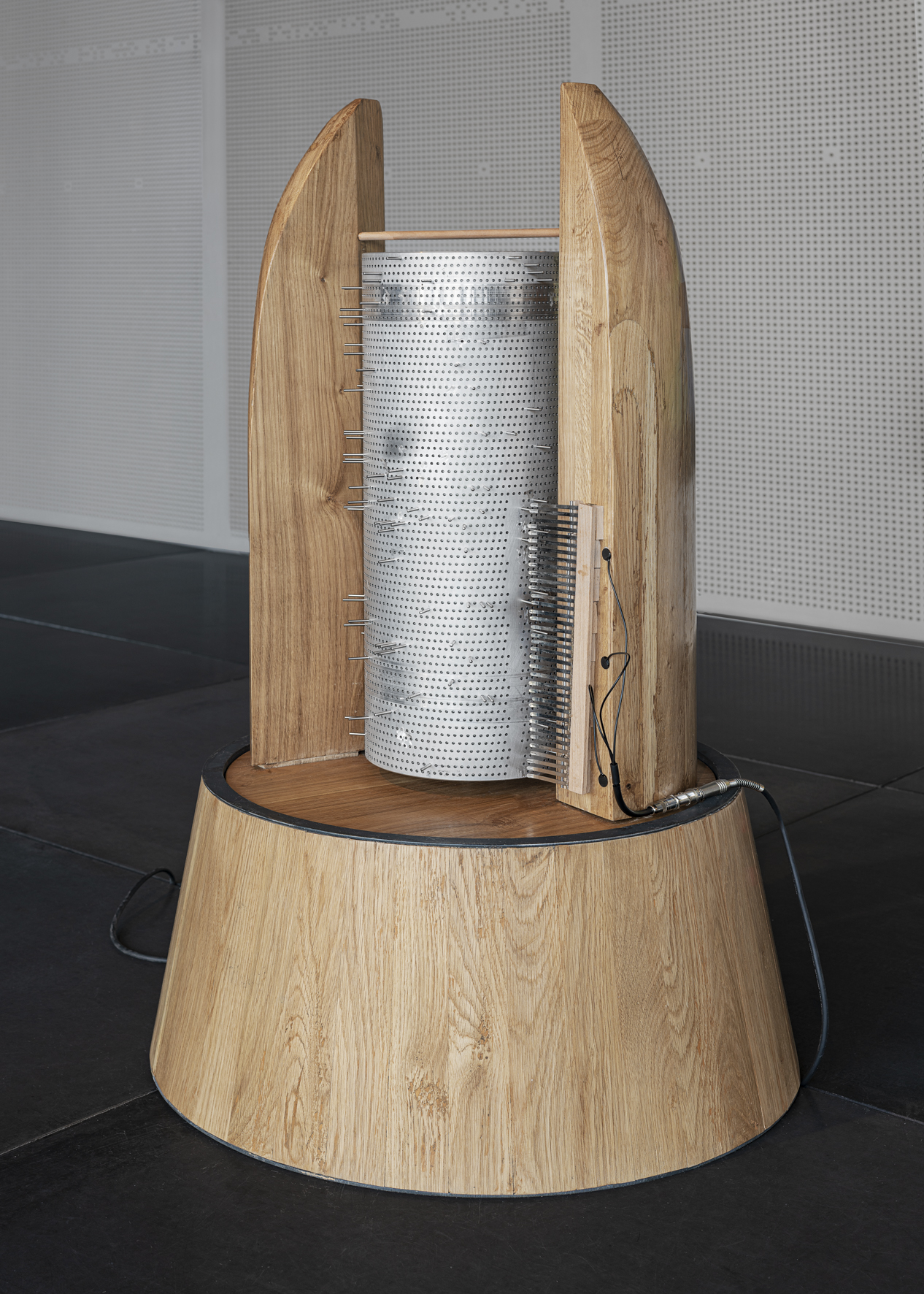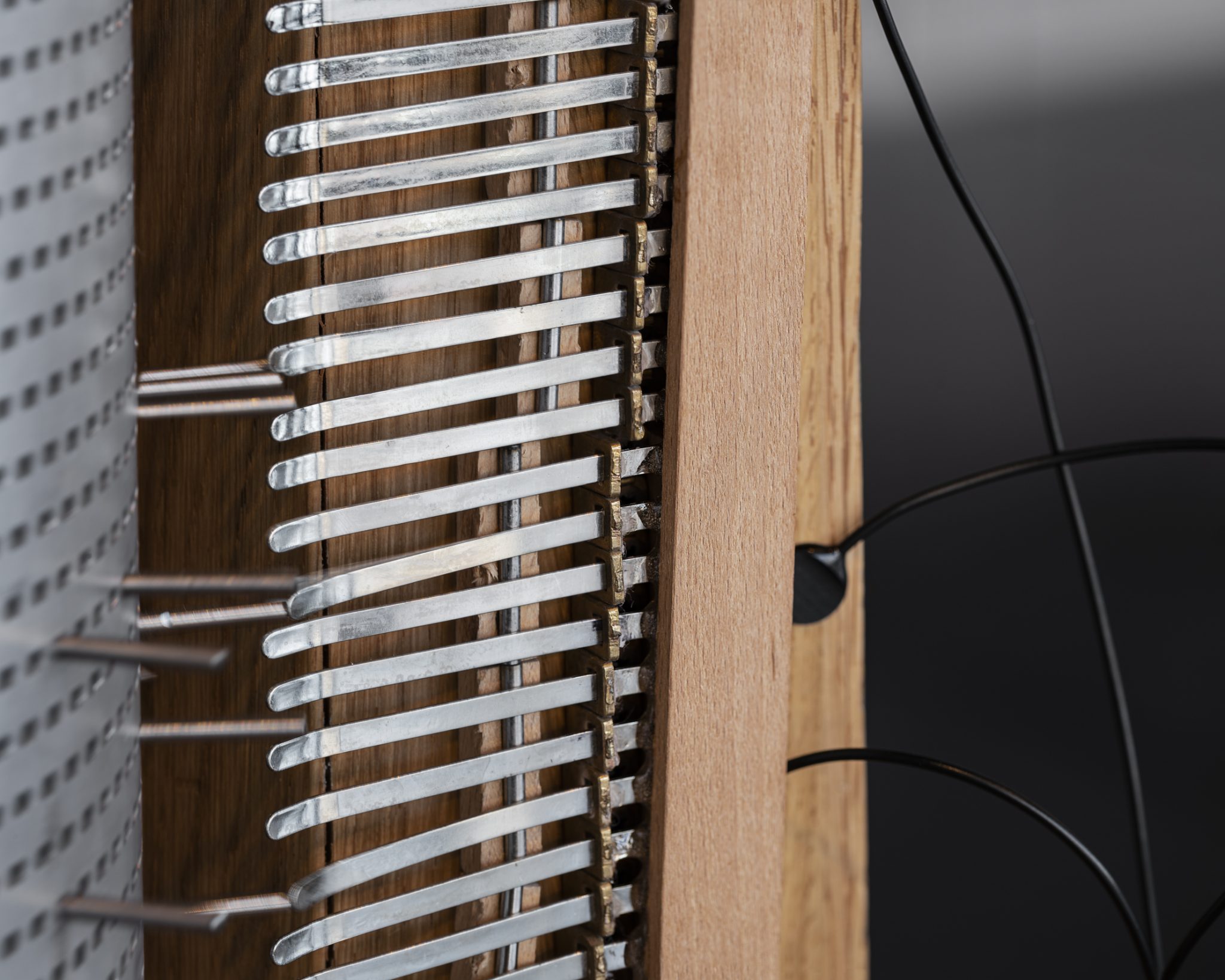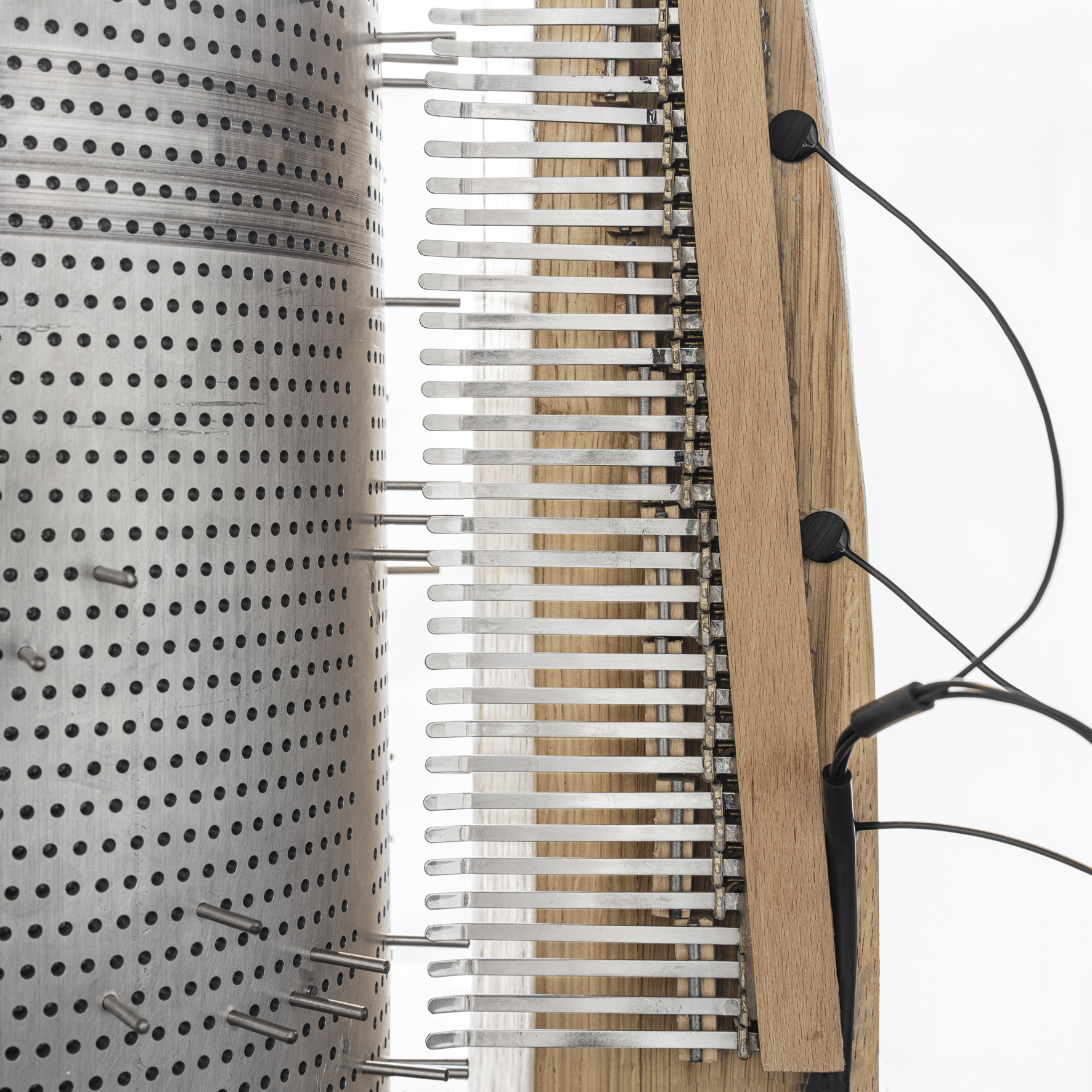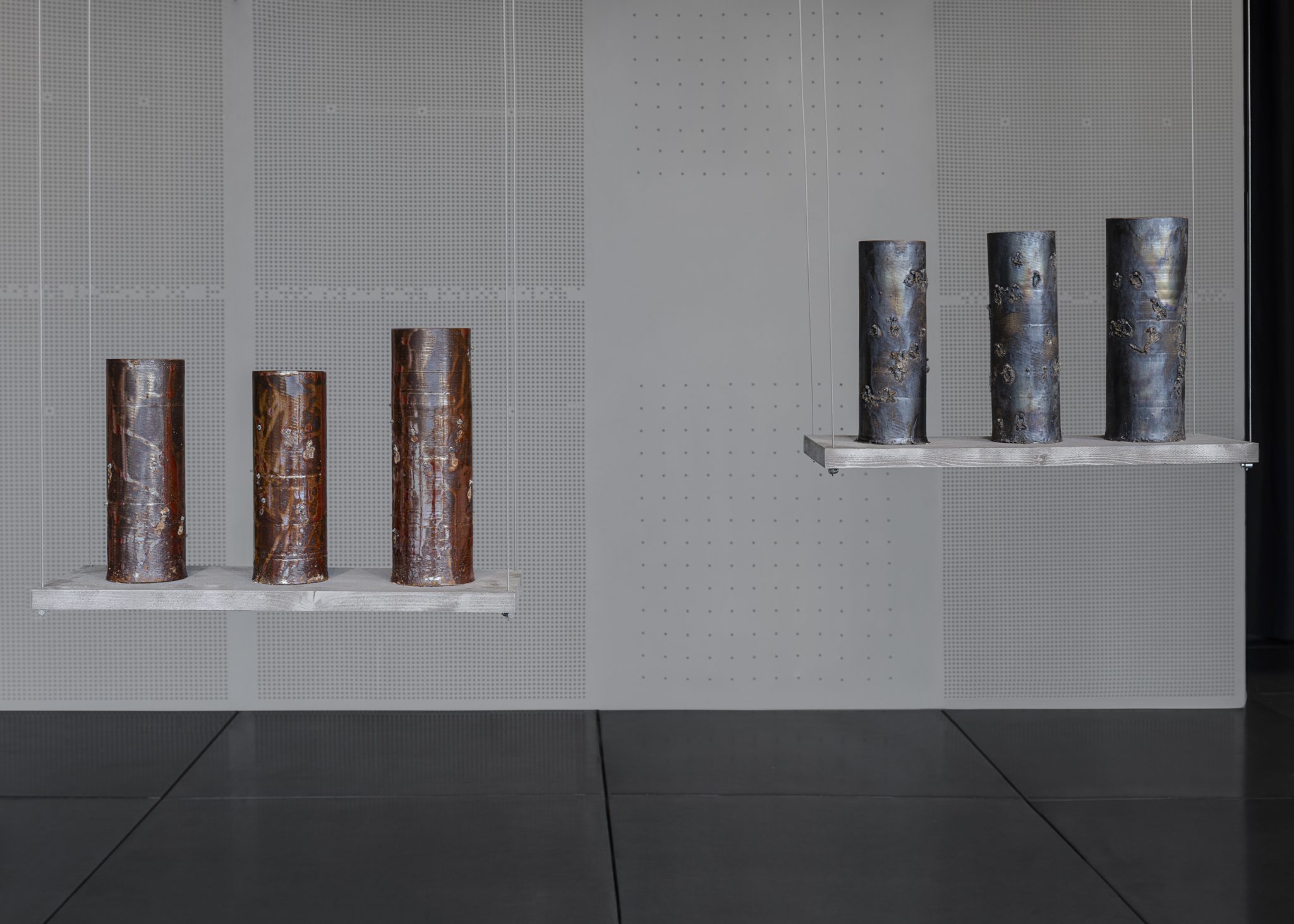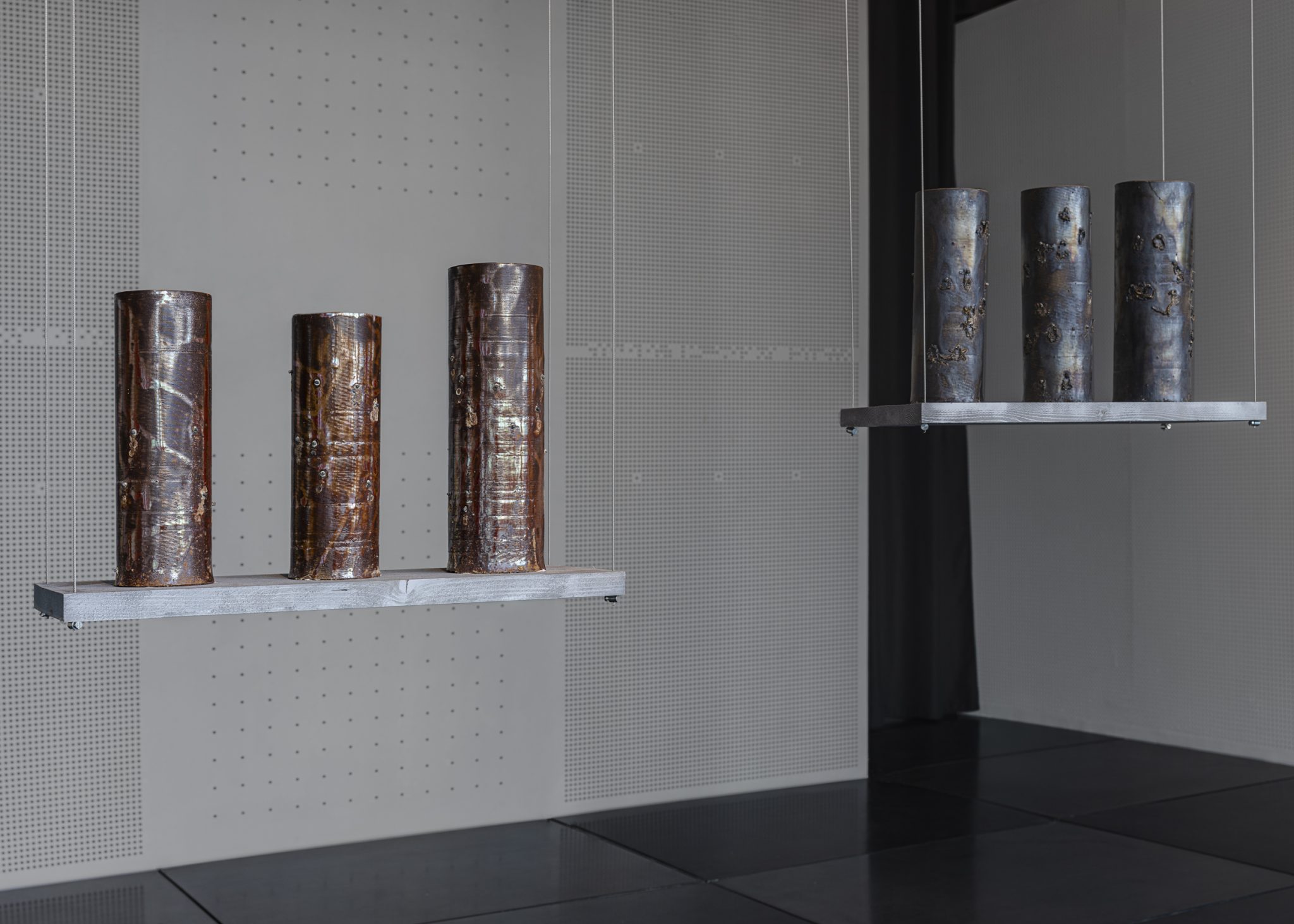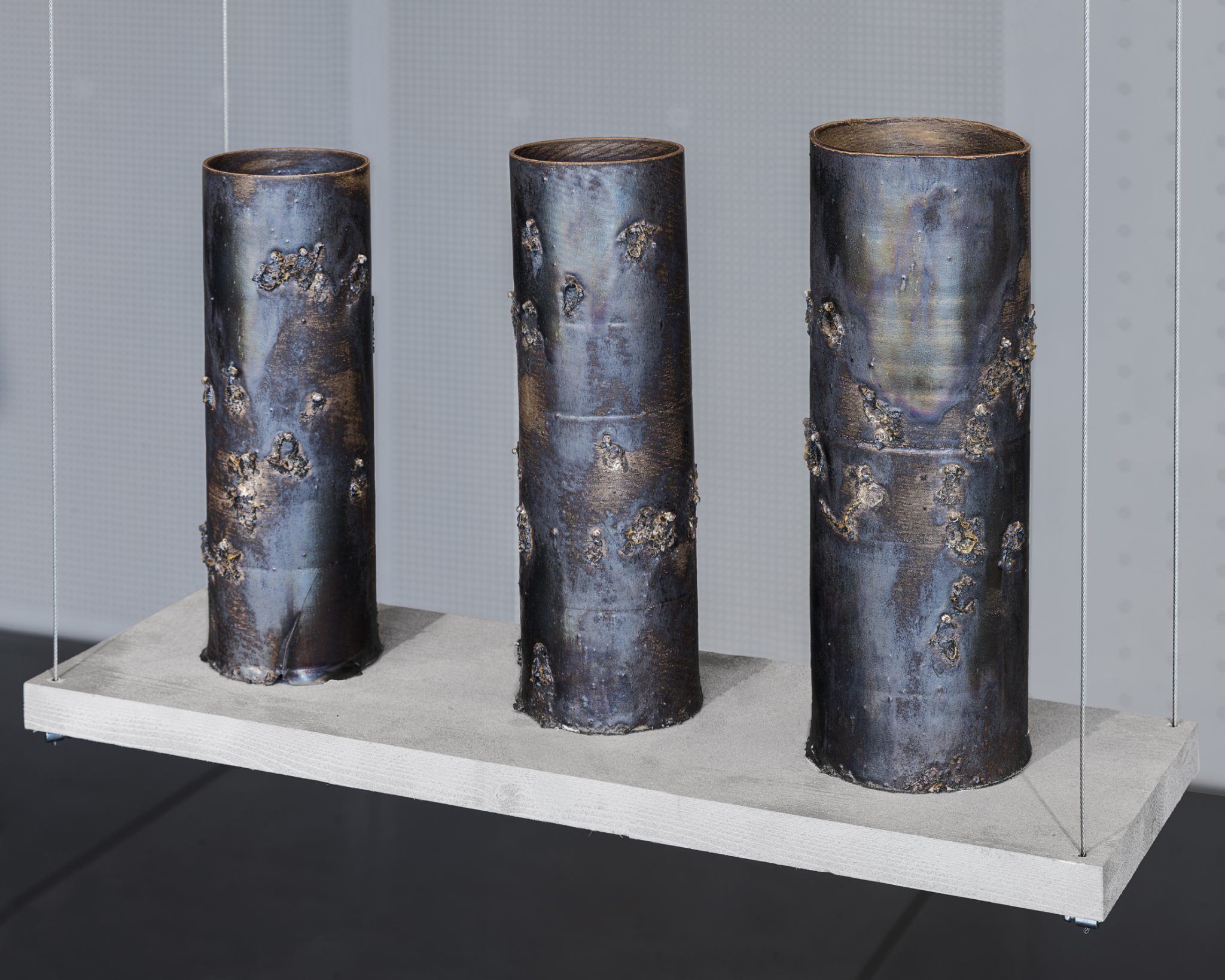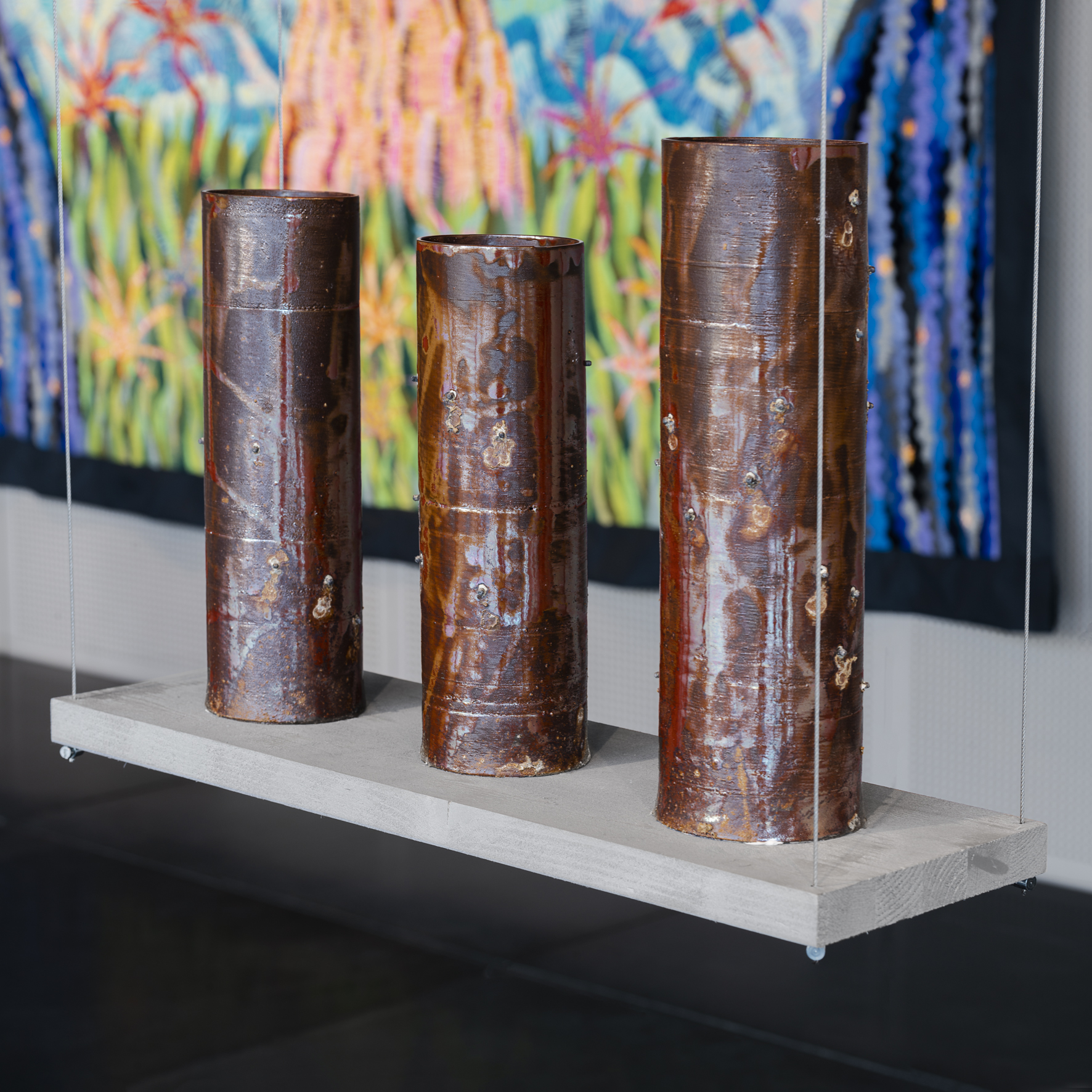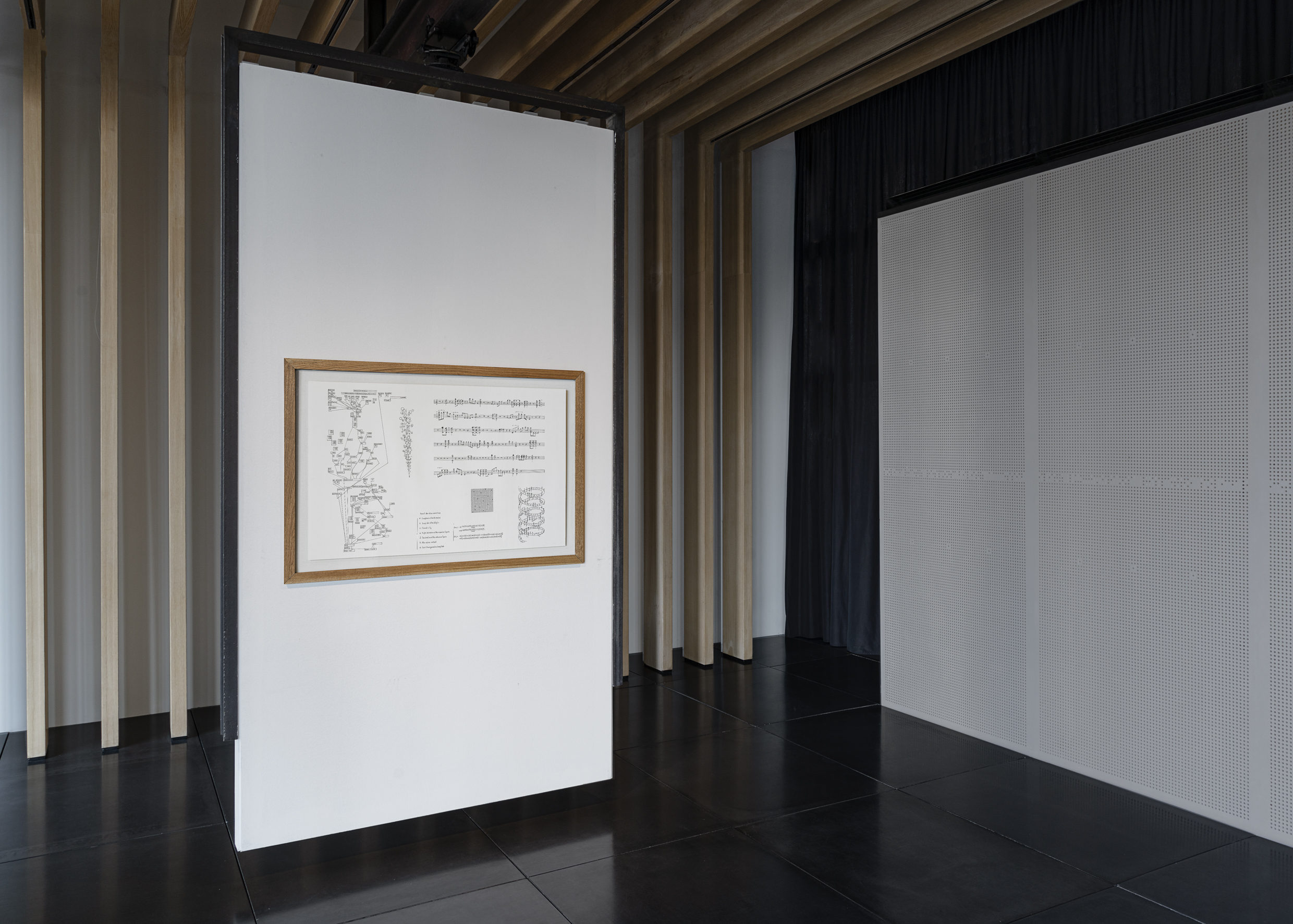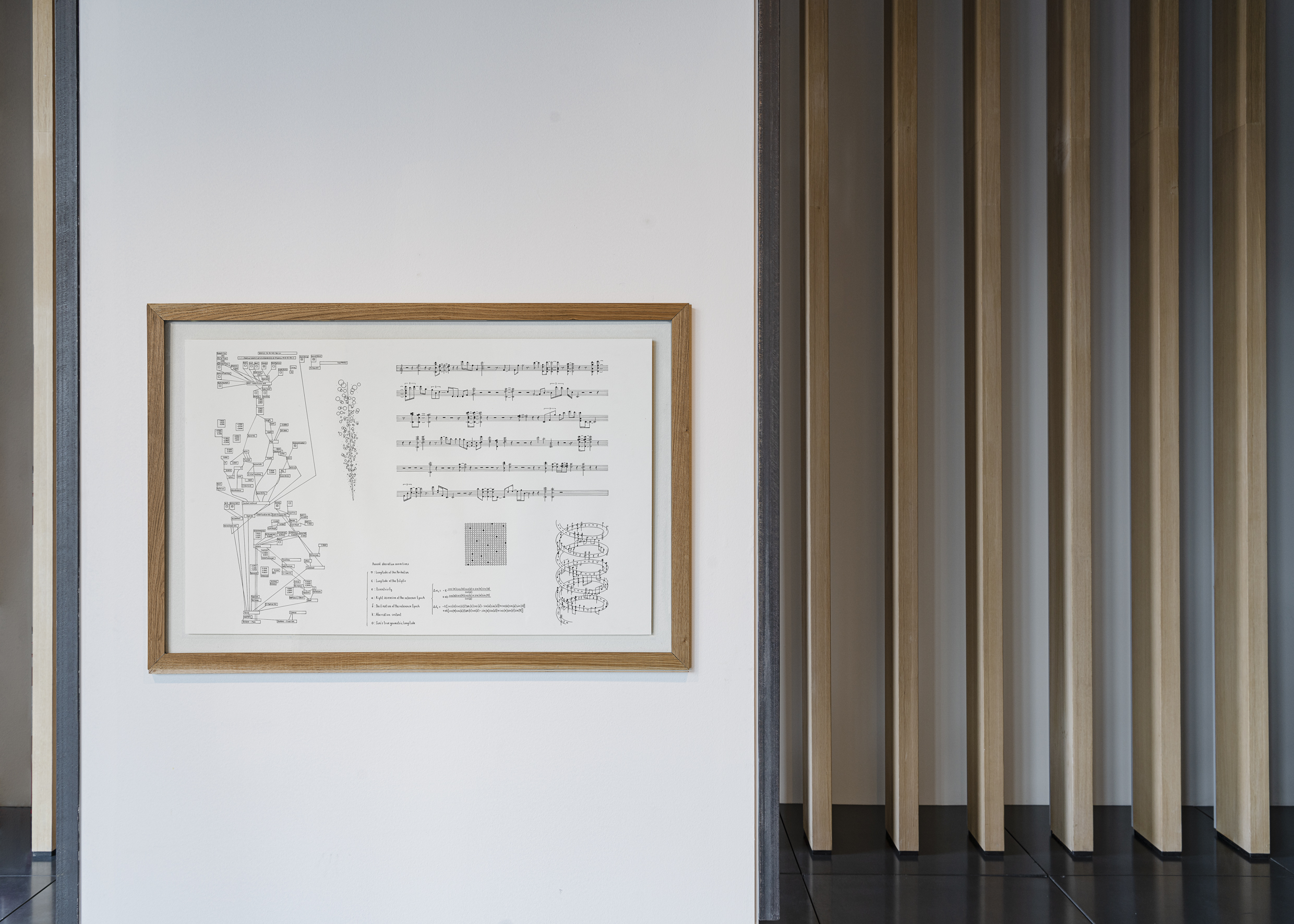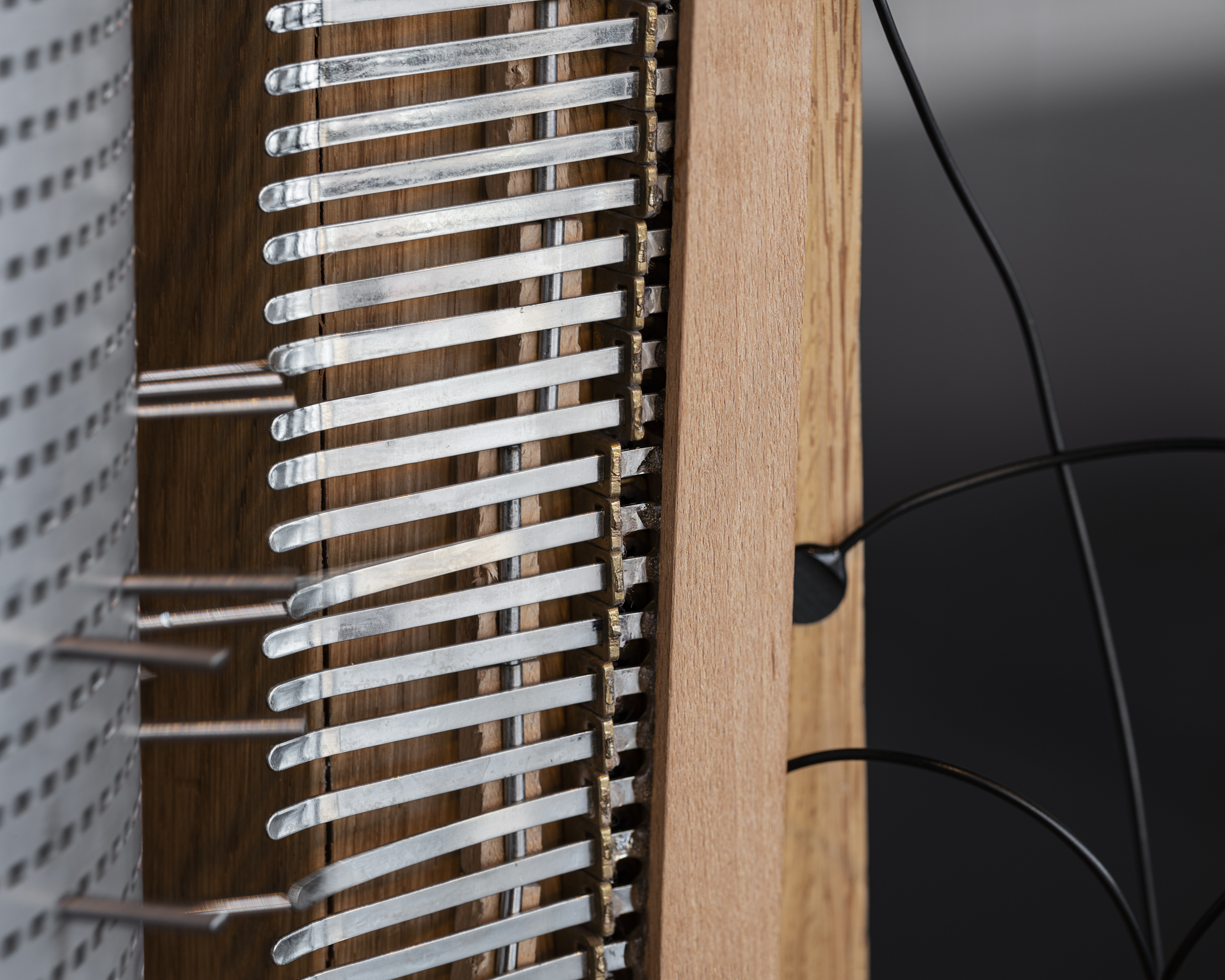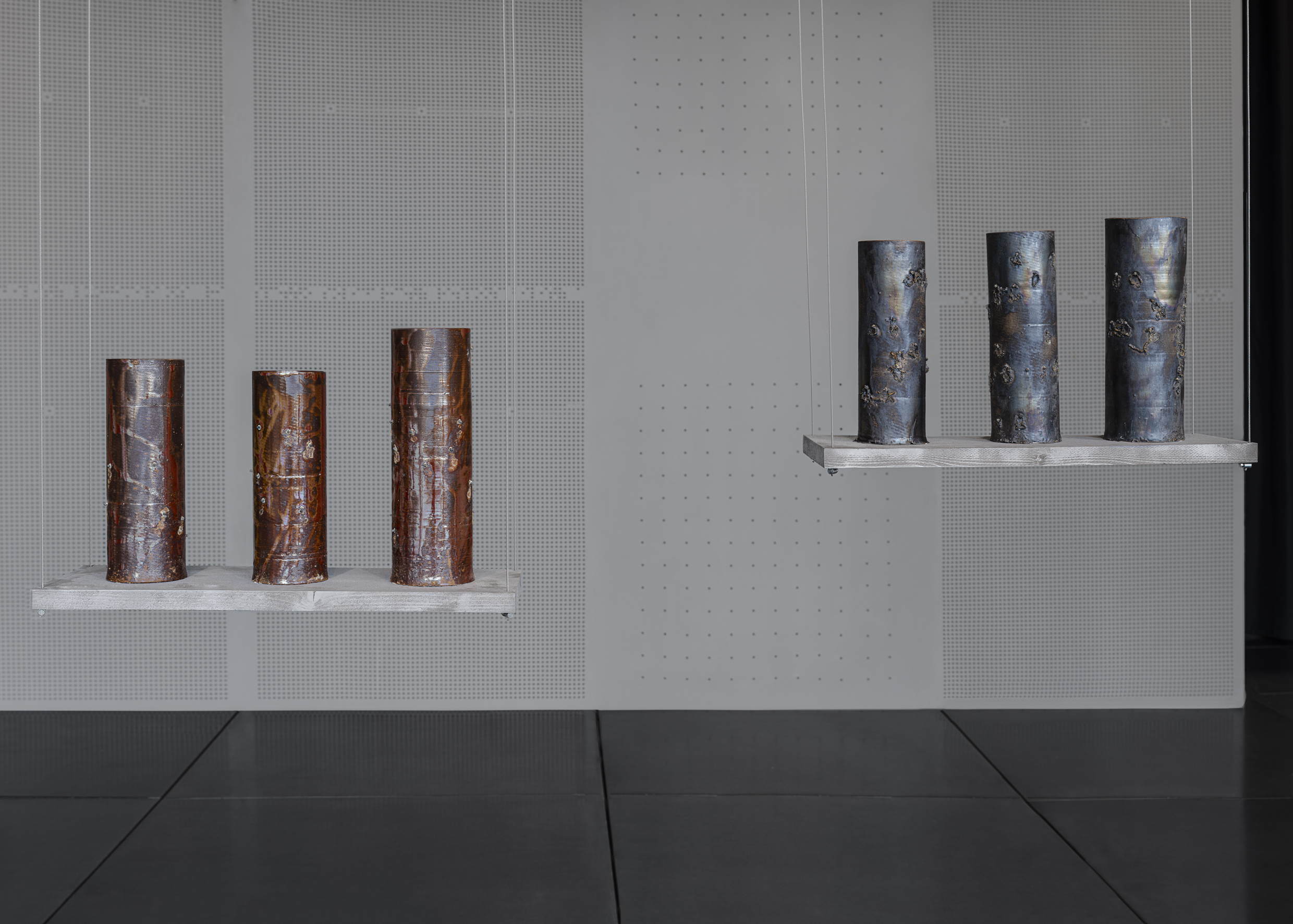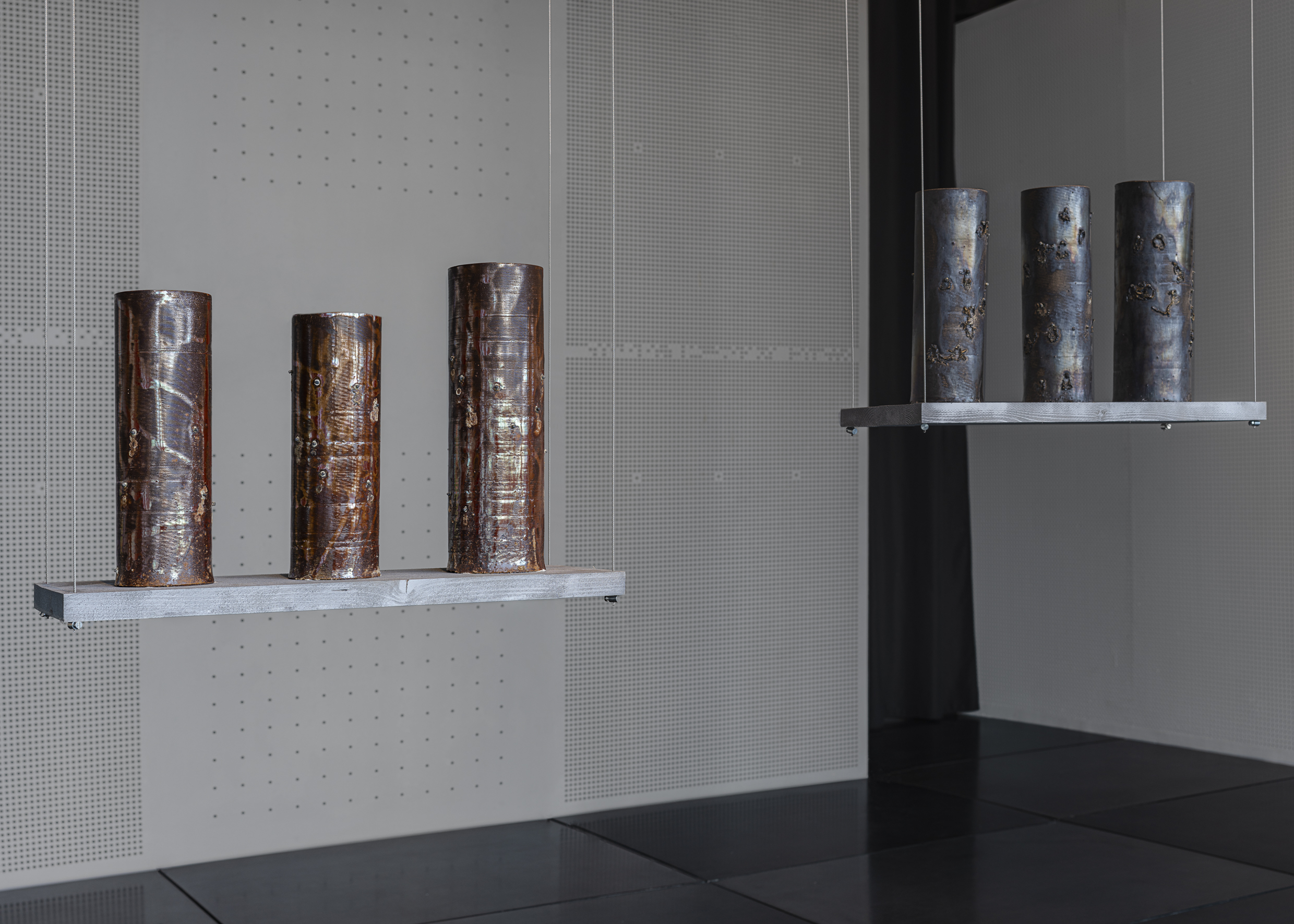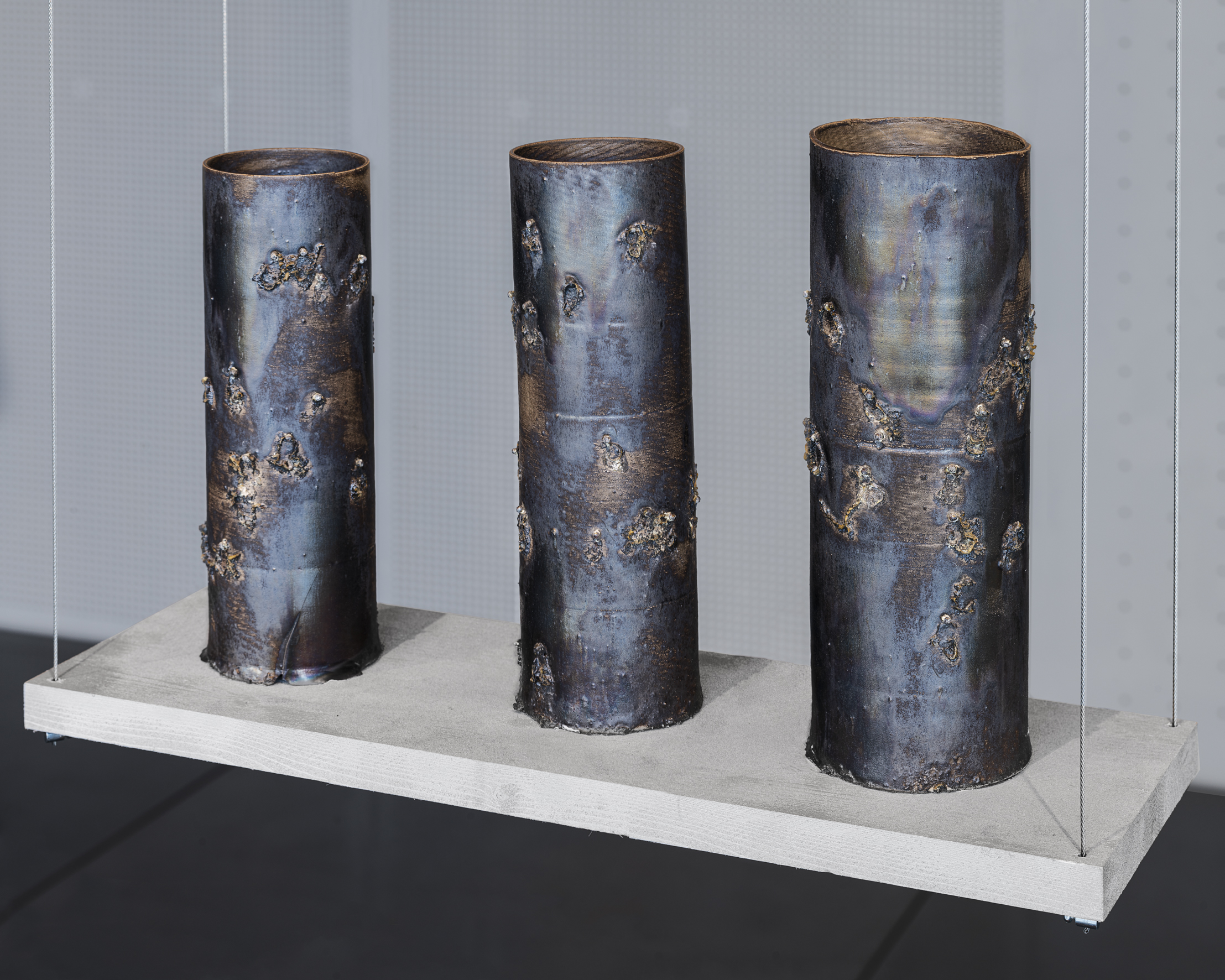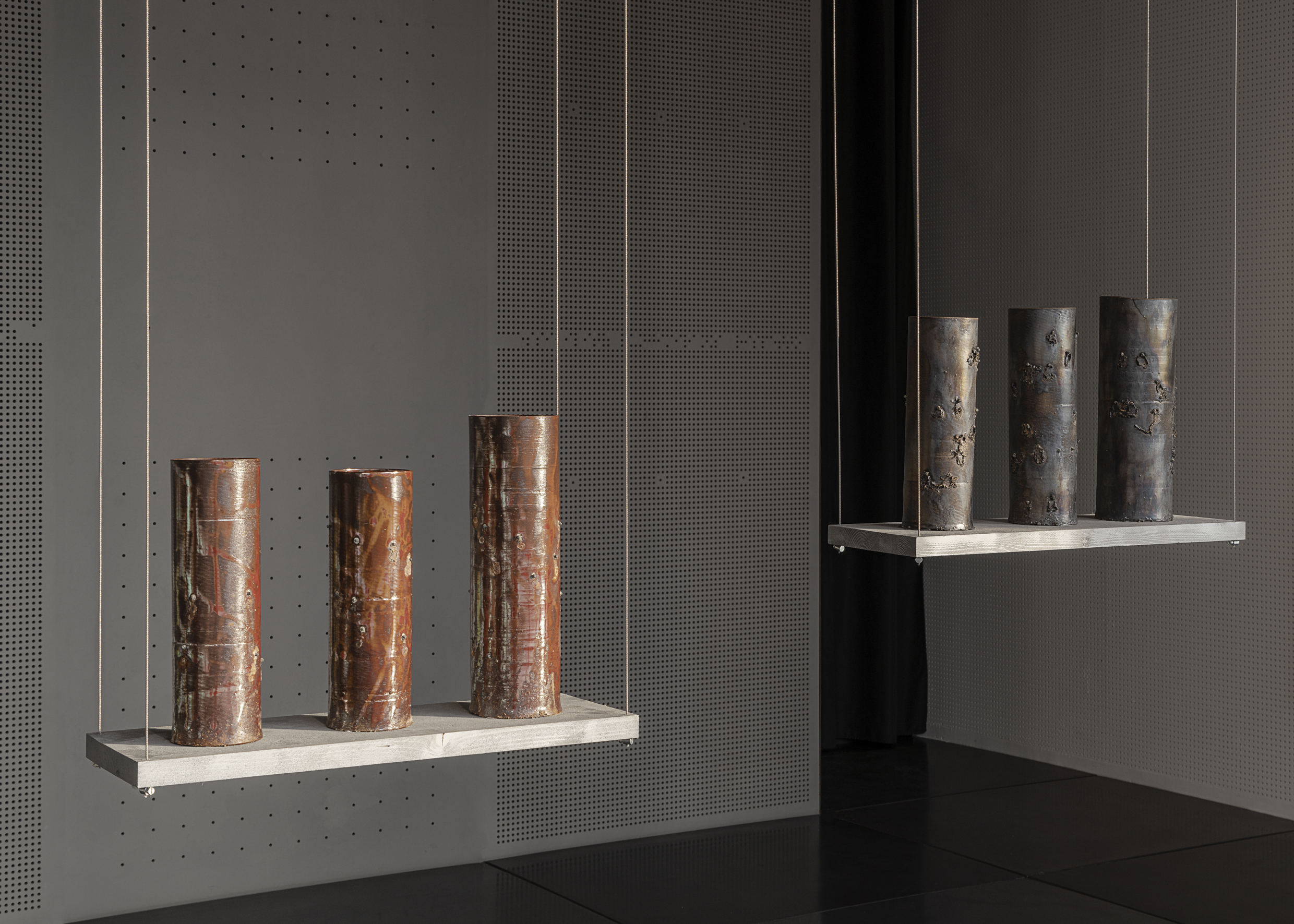Exhibition
Matteo Nasini – Remonte Armonie
January 21st – May 29th, 2021
CUBO, Museo d’Impresa del Gruppo Unipol, Bologna
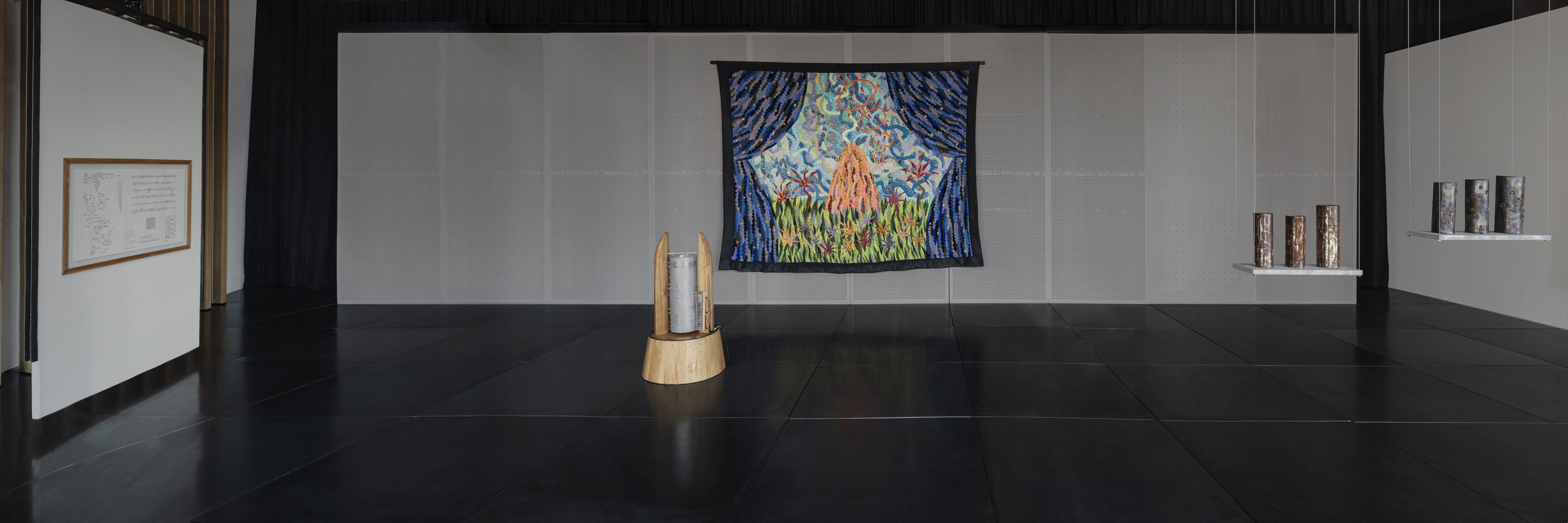
It seems appropriate to introduce the Remote Armonie exhibition by Matteo Nasini with a quote from the Franco-American composer Edgar Varèse, taken from the collection of texts “Il suono organizzato”:
“For me there is more musical fertility in contemplating the stars – better if through a telescope – and in the sublime poetry of certain mathematical expositions than in the more inspired ramblings produced by human passions”.
Before commenting on his meaning and its analogy with Nasini’s entire project, we would like to draw your attention to two expressions used by the composer. The first is “contemplate”. The word has a Latin root, formed by “cum”, meaning with, and “templum”, meaning “section”, probably derived from the Greek word “tèmenos” meaning fence, circuit, separate place dedicated to the gods. In ancient times it specifically indicated an imaginary space that the Augur marked in the sky with his lituus in order to circumscribe an area within which he made his observations on the flight of birds. It simultaneously meant a portion of a field consecrated, always by the Augur, and destined for religious purposes. Thus from its very origin, the word indicated both a celestial and an earthly space. Over time it began to indicate the action of observing a free and vast space in which the gaze can wander to one’s liking, a place in which to receive visual information.
Vision is by far the sense most used by humans, occupying a larger portion of the brain than that occupied in other animal species. In the scientific field, light has been the main means of investigating and collecting information for many years.Everything we know about the stars, our galaxy and by extension the entire universe, we learned through their light.
The second term used by Varèse is “mathematical expositions”. In December 2013, the European Space Agency (ESA) launched the satellite Gaia (Global Astrometric Interferometer for Astrophysics) with the aim of making astrometric measurements, i.e., collecting data relating to the positions, distances and movements of stars and other celestial bodies, which will support studies of the structure and evolutionary history of our galaxy. The satellite uses photometry (the measurement of the intensity of an astronomical object’s electromagnetic radiation) to define the brightness, temperature, gravity, and chemical composition of each celestial body.
In April 2018, ESA published the data of the measurements made between July 2014 and May 2016: a table containing an enormous amount of extremely complex data relating to 1.7 billion celestial bodies.
In collaboration with programmer Nicola Saponaro and physicist Massimo Margotti, Matteo Nasini developed the beta version of a patch able to extrapolate and process this data. Starting from a specific GPS coordinate, the software constructs an imaginary vertical line and projects it to the limits of our galaxy. When a celestial object intercepts this ideal line, it varies its length, and the software calculates its position by translating it into a particular sequence of notes that are recorded on a score. The rules by which the notes are generated depend on a harmonic system the artist specifically developed by studying the relationship between the range of sound perceivable by man and the depth of the Milky Way in light years.
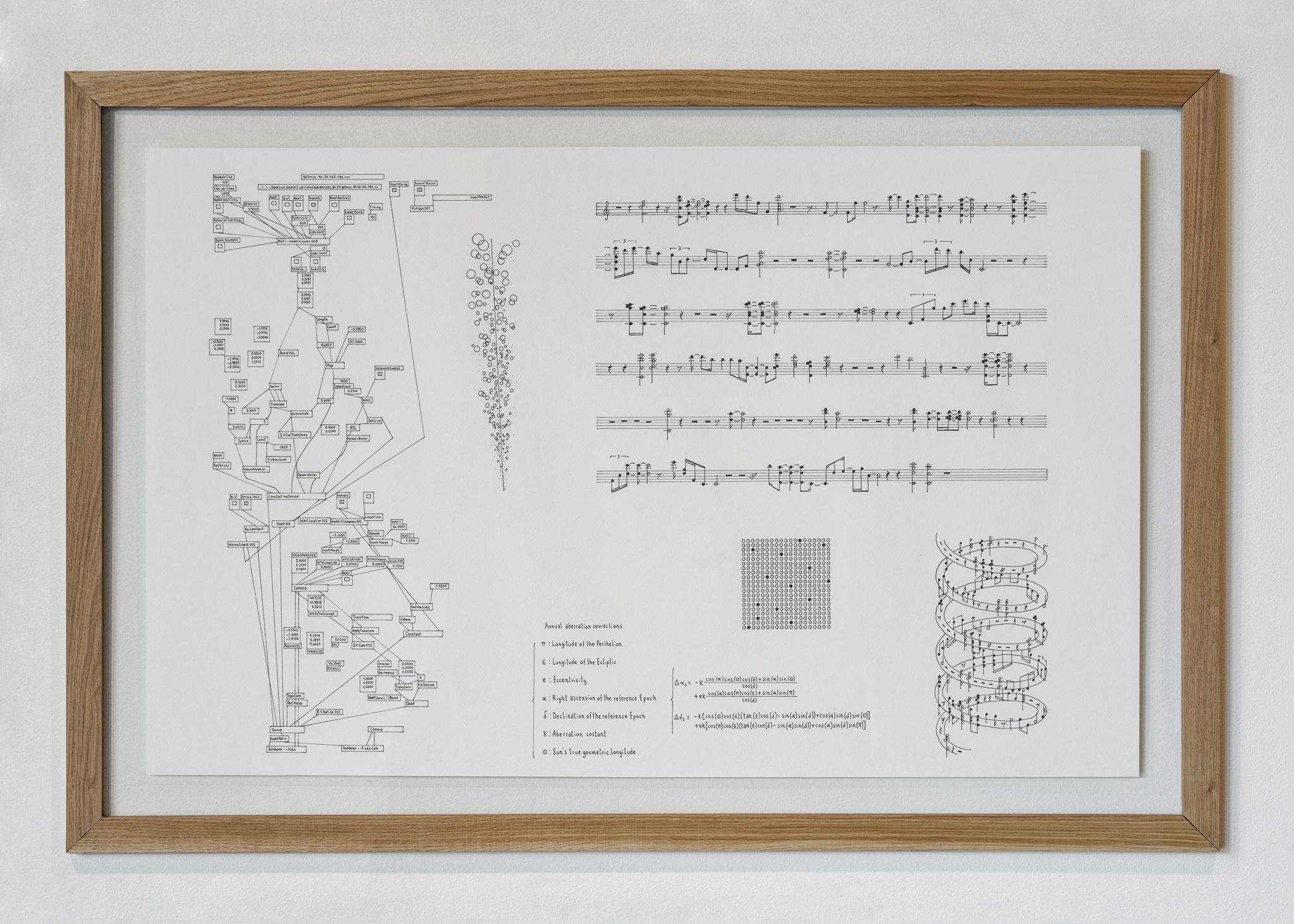
In short, the system Nasini developed transforms the various distances, temperatures and characteristics of each individual celestial body into sound, making the passage of the stars of our galaxy audible on a human scale.
Music which arises from the contemplation of stars and mathematical elaboration, to paraphrase Varèse.
In Remote Armonie, the composition is articulated through an endless series of rules and cycles that as humans we are not yet able to elaborate and conceive in their entirety.
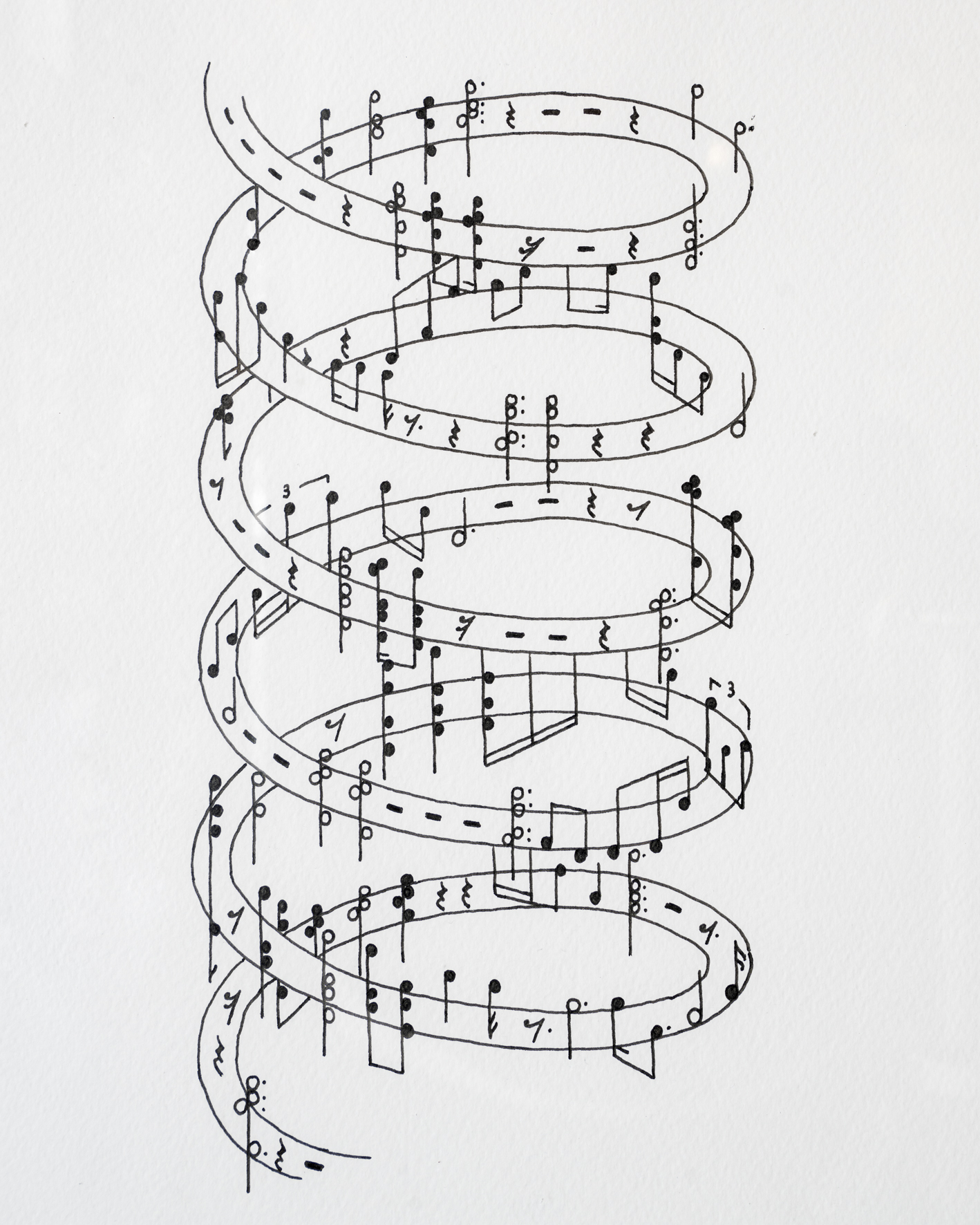
Faced with the concrete vastness of the Universe and its complexity, Nasini listened with an attitude of active reception. Using the most advanced digital technology made available by his time, he interpreted the immense amount of electromagnetic waves captured by the Gaia satellite, transformed into data computable by ESA, and translated them into the universal language of music.
This process, in which an element of reality is studied, processed and returned in fantastic form, is found throughout his artistic research.
In Sparkling Matter, Nasini develops “concerts for sleeping brains”: the signal of the encephalogram of a sleeping person is processed by a software developed by the artist, which translates the frequencies of the phases of sleep into sounds and sculptures. The artist listens in this project too, having carefully built an architecture that the sleeping person inhabits and activates. The musical composition is completely delegated to human thought in its most mysterious and least investigated form, when the mind is free to dream. Nasini presents the project through “sleep concerts”, in which he processes the brain waves of a sleeping performer, transforming them into music. To participate in the event, the audience is invited to stay for the whole night to enjoy the concert and also sleep if they like.
The spectators asleep in the exhibition space, wrapped in blankets designed by the artist, lead us to think about how much music contributes to defining the space where it is enjoyed: an auditorium is designed to listen to music while seated, a disco to dance upright. On the other hand, consider an indefinite space, indeed, definable only through rare finds and fossil traces, far away millennia in our past: what kind of music can it have welcomed?
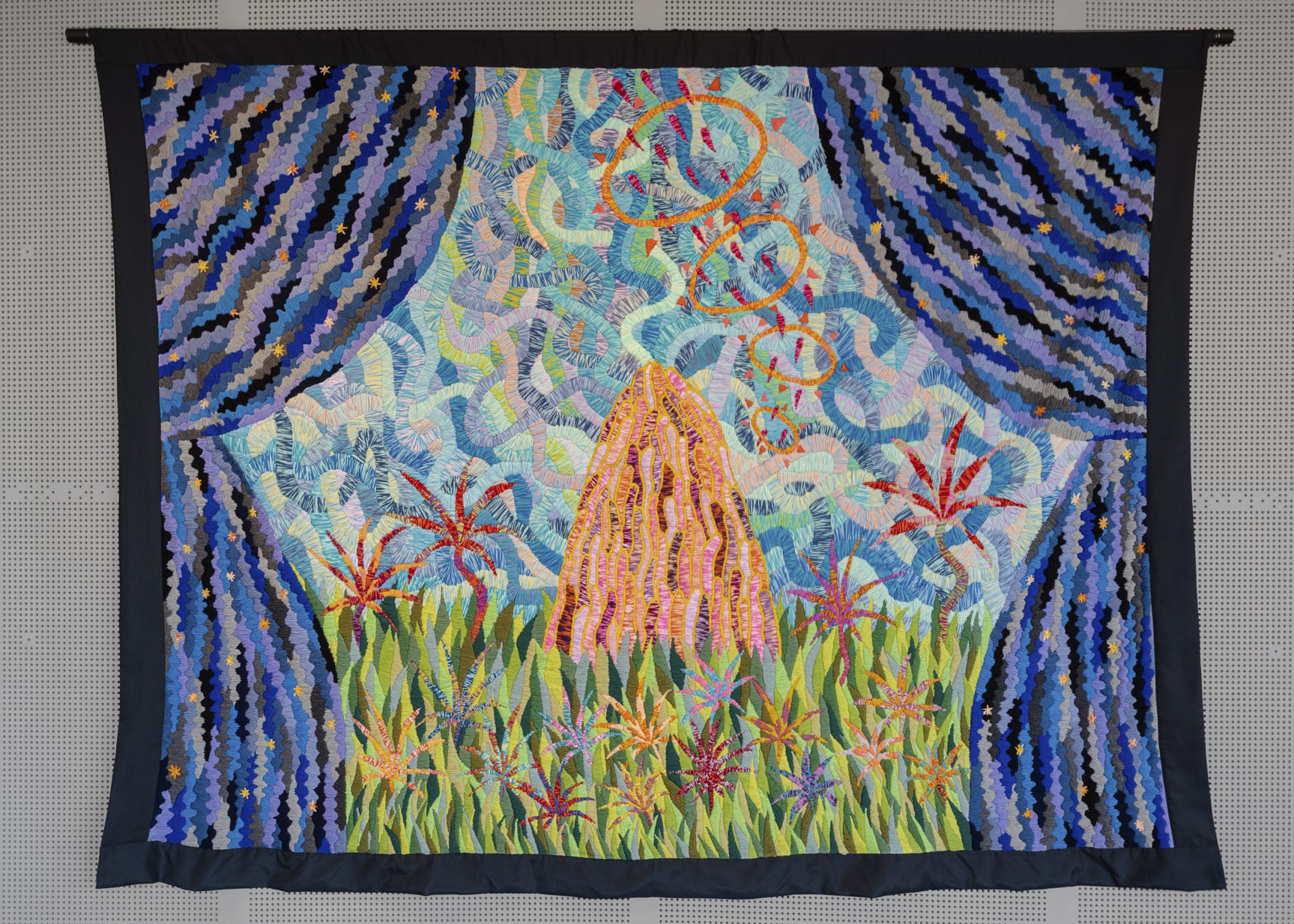
Splendore Neolitico is based on these premises; the project intends to make the sounds of a lost time reach our present. In collaboration with the Museum of Natural History of Verona, the artist identified and scanned a series of fossil bones of animals which lived in the Pleistocene Epoch and had been excavated, carved and used as wind instruments by our predecessors. Nasini reproduced them in ceramic using a three-dimensional printing process. The instruments/sculpture were used during performances to play a composition inspired by the oldest musical practices. The German musicologist Marius Schneider, who devoted his life to the attempt to recompose archaic cosmology based on sound, wrote in his fundamental book “La Musica Primitiva”: “Located between the darkness and the light of the first day, on the human level music lies between the darkness of unconscious life and the clarity of intellectual representations; it therefore belongs largely to the dream world. In the first stage of creation, during which sounds are gradually covered in light, music prepares the intelligible language like dawn precedes day. At the same time it encloses darkness and light, water and fire. Music is the damp sun that sings the dawn”.
Nasini works on themes that many artists of different eras have examined, including the dream, the tension towards an archetypal dimension and focusing on the “mysterious” aspects of our daily life. The use of electroencephalograms and the construction of software in his research do not indicate a particular fascination with technology, but the possibility of using that which is available to him in his time in order to investigate reality, to restore importance and emphasis on the spiritual dimension of our existence.
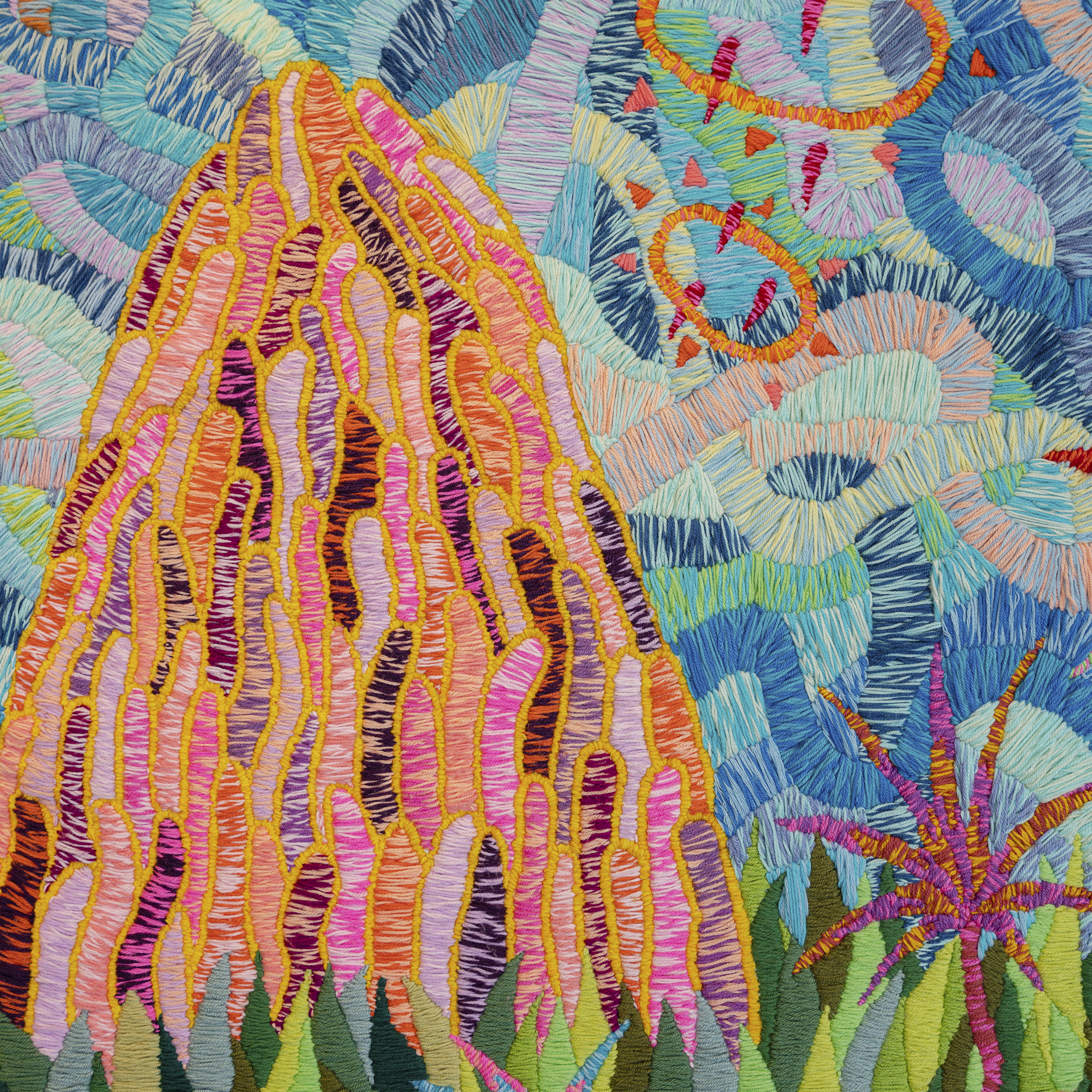
To highlight the relationship between technology and the fantastic dimension in Nasini’s work, we thought of recounting a technically complex project such as Remote Armonie through Il Canto degli Erranti, an audio-drama that presents its themes in the form of a narrative.
The story is set in a future where every trace of technology has disappeared. Science is interpreted not as a tool to investigate reality, but as a fixed and immutable dogma. It is used by an elite as a base from which to exercise and maintain power. A strange interpretation of mathematics, geometry and computer programming shapes the way individuals relate to reality. The only technological elements are the remains of a machine that is said to be capable of “playing” the stars. Those who merely name it risk being accused of heresy, incurring severe punishments. This machine, a capsule of experimentation in which science joins art, represents the last hope for a relaunch of scientific research, a hidden piece capable of unlocking reality from that future supported by useless dogmas. Siderino lives in this universe as a young student who at the moment of the story is just beginning his apprenticeship when, through curious events, he comes into contact with one of the pieces of the legendary machine.
To highlight the relationship between technology and the fantastic dimension in Nasini’s work, we thought of recounting a technically complex project such as Remote Armonie through Il Canto degli Erranti, an audio-drama that presents its themes in the form of a narrative.
The story is set in a future where every trace of technology has disappeared. Science is interpreted not as a tool to investigate reality, but as a fixed and immutable dogma. It is used by an elite as a base from which to exercise and maintain power. A strange interpretation of mathematics, geometry and computer programming shapes the way individuals relate to reality. The only technological elements are the remains of a machine that is said to be capable of “playing” the stars. Those who merely name it risk being accused of heresy, incurring severe punishments. This machine, a capsule of experimentation in which science joins art, represents the last hope for a relaunch of scientific research, a hidden piece capable of unlocking reality from that future supported by useless dogmas. Siderino lives in this universe as a young student who at the moment of the story is just beginning his apprenticeship when, through curious events, he comes into contact with one of the pieces of the legendary machine.
Siderino is named after Sidereo, the central work around which the Remote Armonie exhibition revolves. It is an electromechanically activated music box: on the occasion of the exhibition, it can be started remotely using the signal coming from the CUBO App, from which it is also possible to listen and watch live. Built in oak, it has two uprights between which an aluminium cylinder rotates, on which pins are mounted that trigger intoned strips, setting them vibrating. The pins are arranged on the cylinder so that they perform two minutes of a star score corresponding to the motion of the stars above the artist’s Roman studio on his birthday, 22 January 2021. The central cylindrical element of Sidereo acts as inspiration for the sculptural group Transtamburo, consisting of six ceramic sculptures with metal grafts. The exhibition project ends with two works ideally at the antipodes, as at the antipodes are both the scientific discussion of the entire project and its narrative rendering in Il Canto degli Erranti. Mangiastelle assiale is a tapestry made of wool that represents a fantastic landscape framed by a curtain. Having the appearance of a starry night, it opens (or closes?) on a mountain that rises between plant elements, and whose slopes give rise to sinuous flows that intertwine to form a background. The imaginative representation of this connection between earth and sky acts as a metaphor for the operation of the software, represented in its founding parts on the Sidereo calligraphy. The work on paper graphically reports the development and transformation processes of the informations present in the star catalogues into useful data to be written in the form of a score, and subsequently transferred to the outer surface of the Sidereo sculpture’s cylinder, becoming its executive notation. The calligraphic work represents an overlapping of different moments during the project for the construction of the sound sculpture through the development of the central drum, some screenshots of the algorithm’s operation and the relative musical scores.
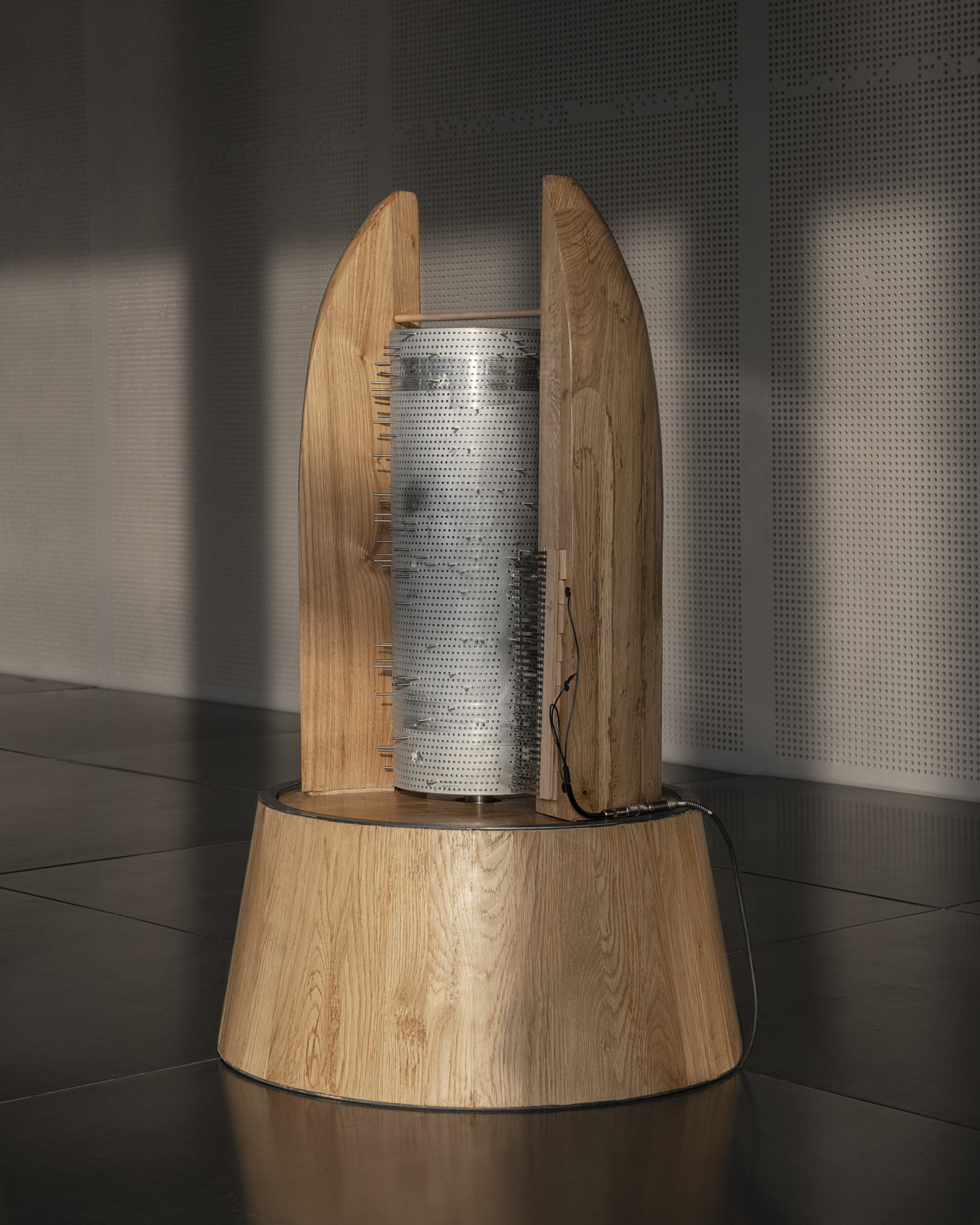
Remote Armonie is the first piece of a far-reaching project whose objectives include emphasizing the isolation of our planet from the rest of the galaxy, in the hope that the music generated by its inspection of Space will make humanity aware of the arbitrariness of all those divisions that generate conflicts, producing a feeling of universal community and revealing the effective union of all of humanity in the same journey towards the unknown.
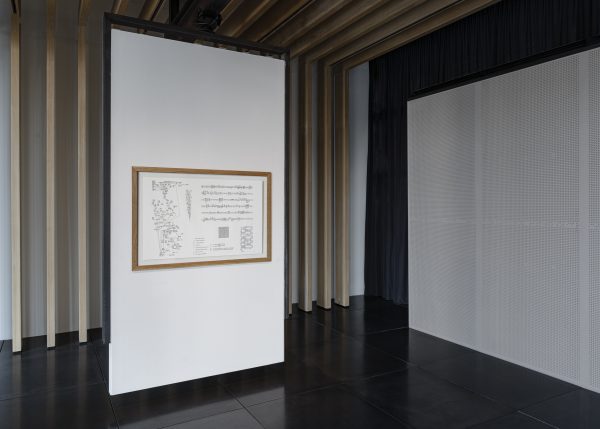 Matteo Nasini, Remote Armonie, 2021Sidereo, 2021. Ink on paper. CUBO Unipol, Bologna. Courtesy of the artist and CUBO Unipol. Photo: Flavio Pescatori
Matteo Nasini, Remote Armonie, 2021Sidereo, 2021. Ink on paper. CUBO Unipol, Bologna. Courtesy of the artist and CUBO Unipol. Photo: Flavio Pescatori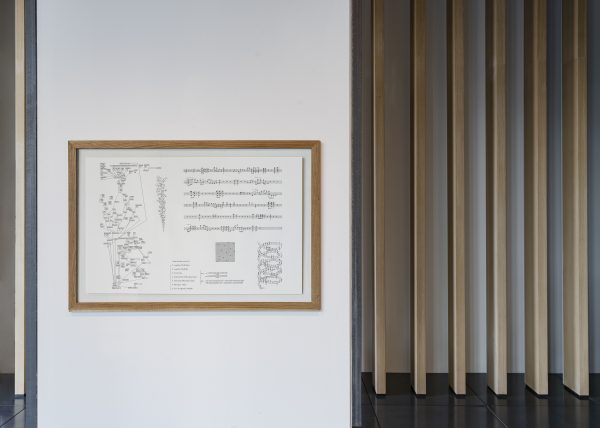 Matteo Nasini, Remote Armonie, 2021Sidereo, 2021. Ink on paper. CUBO Unipol, Bologna. Courtesy of the artist and CUBO Unipol. Photo: Flavio Pescatori
Matteo Nasini, Remote Armonie, 2021Sidereo, 2021. Ink on paper. CUBO Unipol, Bologna. Courtesy of the artist and CUBO Unipol. Photo: Flavio Pescatori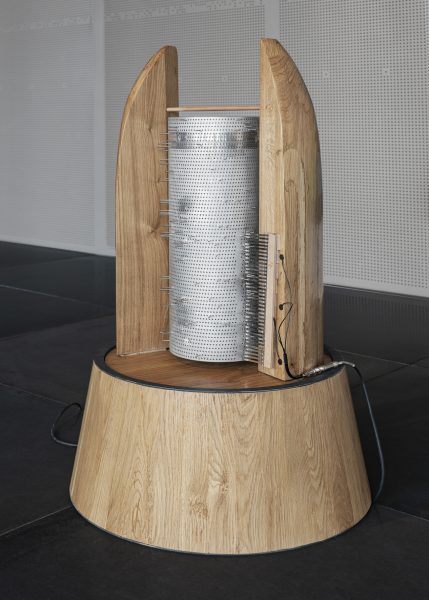 Matteo Nasini, Remote Armonie, 2021Sidereo, 2020 - 2021. Wood, steel and aluminium. CUBO Unipol, Bologna. Courtesy of the artist and CUBO Unipol. Photo: Flavio Pescatori
Matteo Nasini, Remote Armonie, 2021Sidereo, 2020 - 2021. Wood, steel and aluminium. CUBO Unipol, Bologna. Courtesy of the artist and CUBO Unipol. Photo: Flavio Pescatori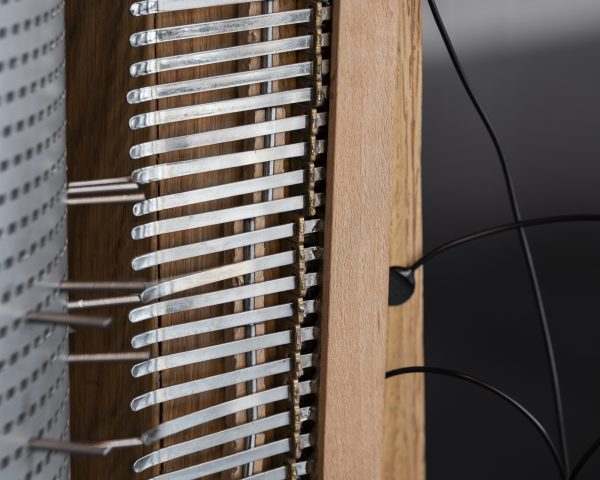 Matteo Nasini, Remote Armonie, 2021Sidereo, 2020 - 2021. Detail. Wood, steel and aluminium. CUBO Unipol, Bologna. Courtesy of the artist and CUBO Unipol. Photo: Flavio Pescatori
Matteo Nasini, Remote Armonie, 2021Sidereo, 2020 - 2021. Detail. Wood, steel and aluminium. CUBO Unipol, Bologna. Courtesy of the artist and CUBO Unipol. Photo: Flavio Pescatori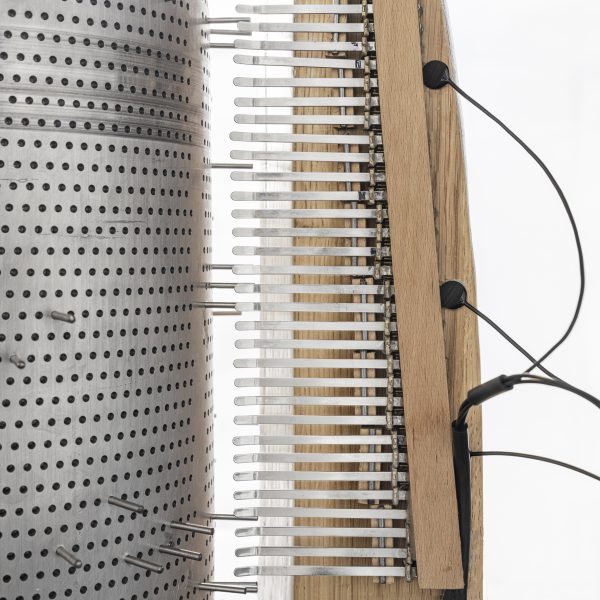 Matteo Nasini, Remote Armonie, 2021Sidereo, 2020 - 2021. Detail. Wood, steel and aluminium. CUBO Unipol, Bologna. Courtesy of the artist and CUBO Unipol. Photo: Flavio Pescatori
Matteo Nasini, Remote Armonie, 2021Sidereo, 2020 - 2021. Detail. Wood, steel and aluminium. CUBO Unipol, Bologna. Courtesy of the artist and CUBO Unipol. Photo: Flavio Pescatori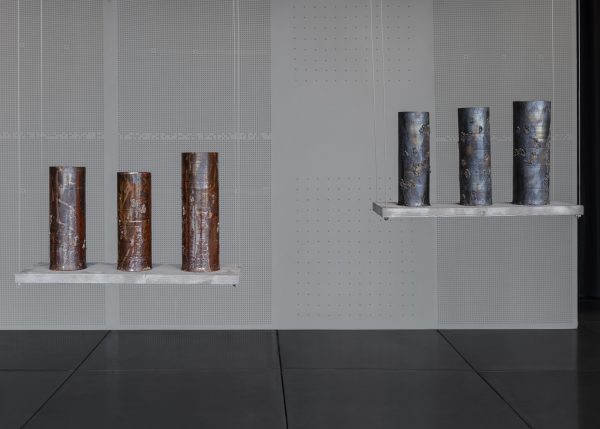 Matteo Nasini, Remote Armonie, 2021Transtamburo, 2020 - 2021. Ceramic, steel. Variable dimensions. CUBO Unipol, Bologna. Courtesy of the artist and CUBO Unipol. Photo: Flavio Pescatori
Matteo Nasini, Remote Armonie, 2021Transtamburo, 2020 - 2021. Ceramic, steel. Variable dimensions. CUBO Unipol, Bologna. Courtesy of the artist and CUBO Unipol. Photo: Flavio Pescatori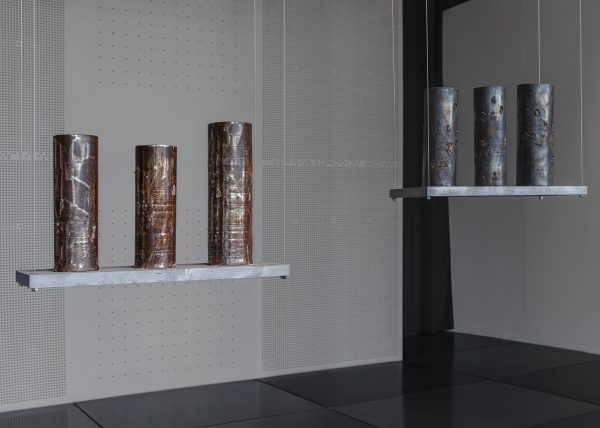 Matteo Nasini, Remote Armonie, 2021Transtamburo, 2020 - 2021. Ceramic, steel. Variable dimensions. CUBO Unipol, Bologna. Courtesy of the artist and CUBO Unipol. Photo: Flavio Pescatori
Matteo Nasini, Remote Armonie, 2021Transtamburo, 2020 - 2021. Ceramic, steel. Variable dimensions. CUBO Unipol, Bologna. Courtesy of the artist and CUBO Unipol. Photo: Flavio Pescatori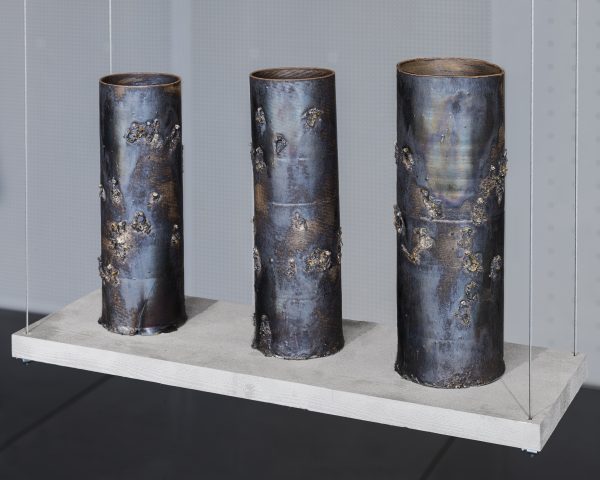 Matteo Nasini, Remote Armonie, 2021Transtamburo, 2020 - 2021. Ceramic, steel. Variable dimensions. CUBO Unipol, Bologna. Courtesy of the artist and CUBO Unipol. Photo: Flavio Pescatori
Matteo Nasini, Remote Armonie, 2021Transtamburo, 2020 - 2021. Ceramic, steel. Variable dimensions. CUBO Unipol, Bologna. Courtesy of the artist and CUBO Unipol. Photo: Flavio Pescatori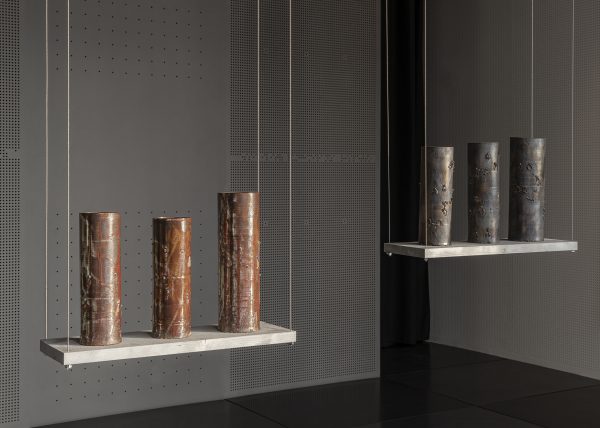 Matteo Nasini, Remote Armonie, 2021Transtamburo, 2020 - 2021. Ceramic, steel. Variable dimensions. CUBO Unipol, Bologna. Courtesy of the artist and CUBO Unipol. Photo: Flavio Pescatori
Matteo Nasini, Remote Armonie, 2021Transtamburo, 2020 - 2021. Ceramic, steel. Variable dimensions. CUBO Unipol, Bologna. Courtesy of the artist and CUBO Unipol. Photo: Flavio Pescatori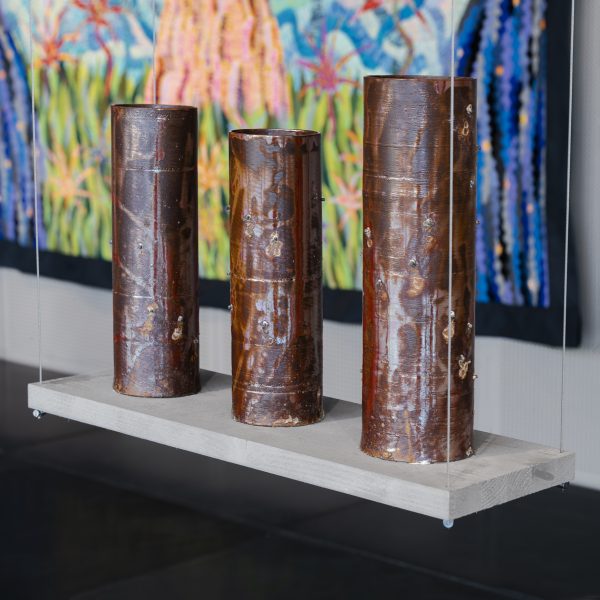 Matteo Nasini, Remote Armonie, 2021Transtamburo, 2020 - 2021. Ceramic, steel. Variable dimensions. CUBO Unipol, Bologna. Courtesy of the artist and CUBO Unipol. Photo: Flavio Pescatori
Matteo Nasini, Remote Armonie, 2021Transtamburo, 2020 - 2021. Ceramic, steel. Variable dimensions. CUBO Unipol, Bologna. Courtesy of the artist and CUBO Unipol. Photo: Flavio Pescatori
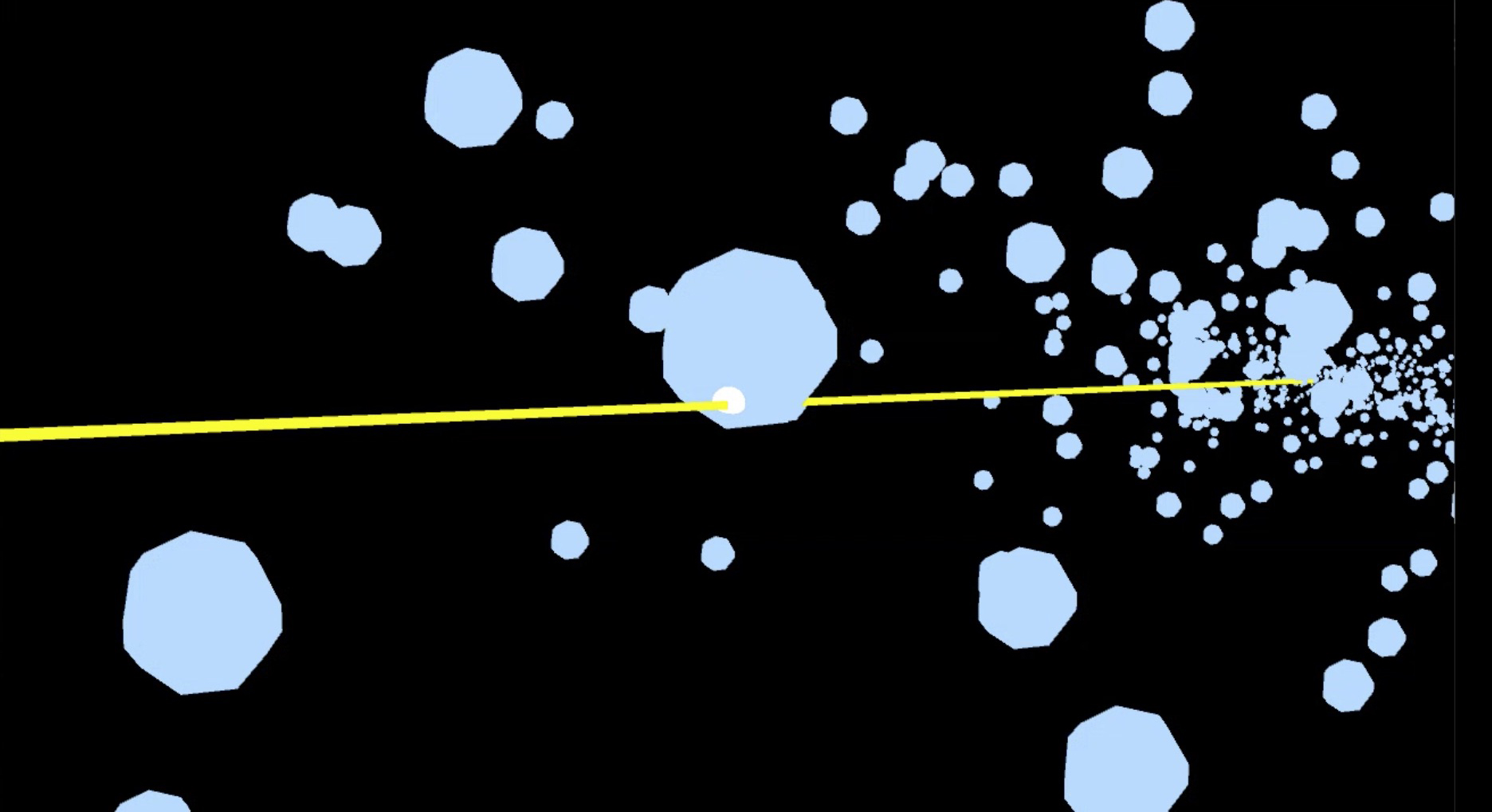
September 14th – November 7th, 2021
Clima, Milano
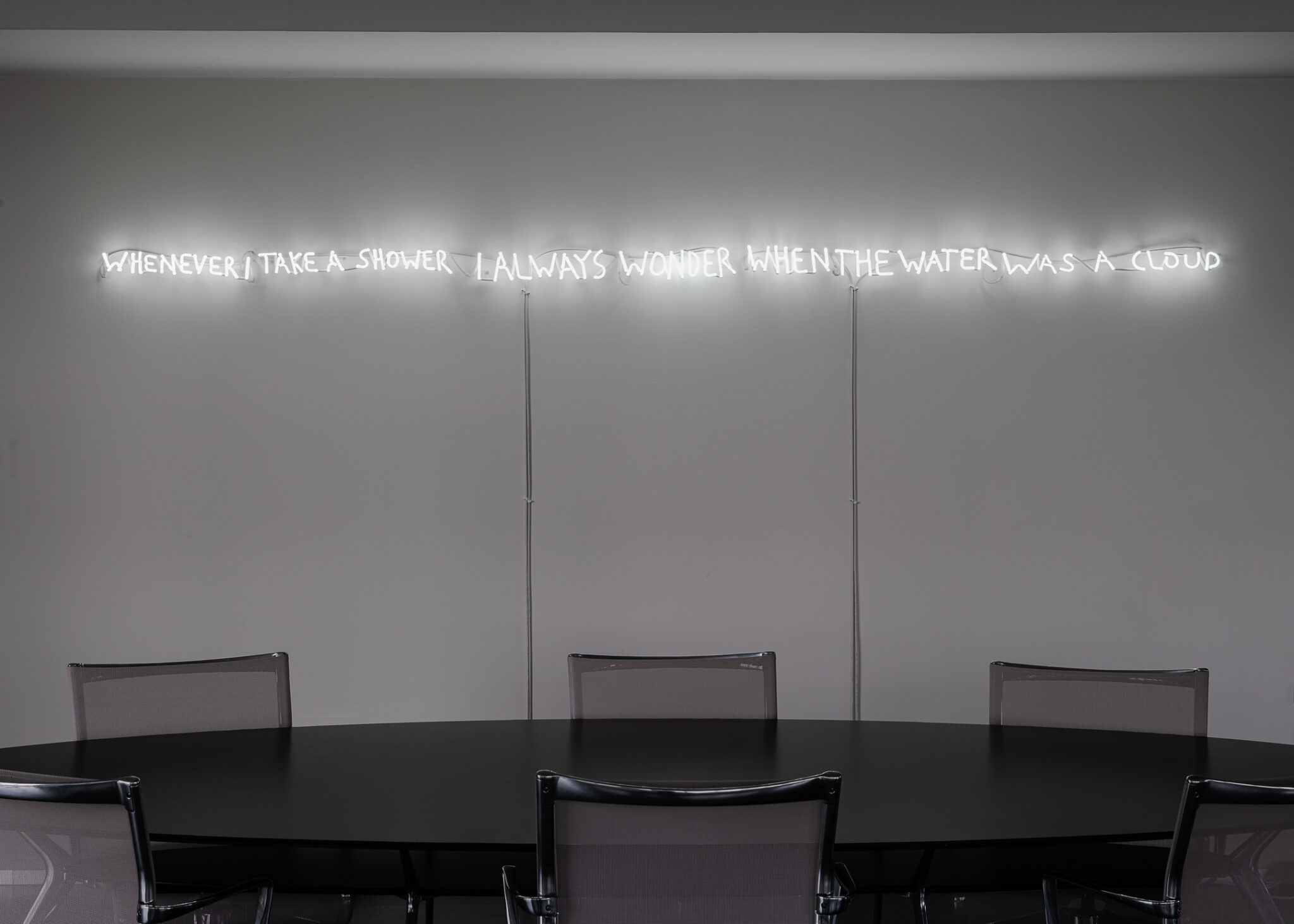
An exhibition of works from the Cristella Collection curated by a supernatural entity, mediated by human beings and presented through multiple circular narratives in the form of a gamebook.
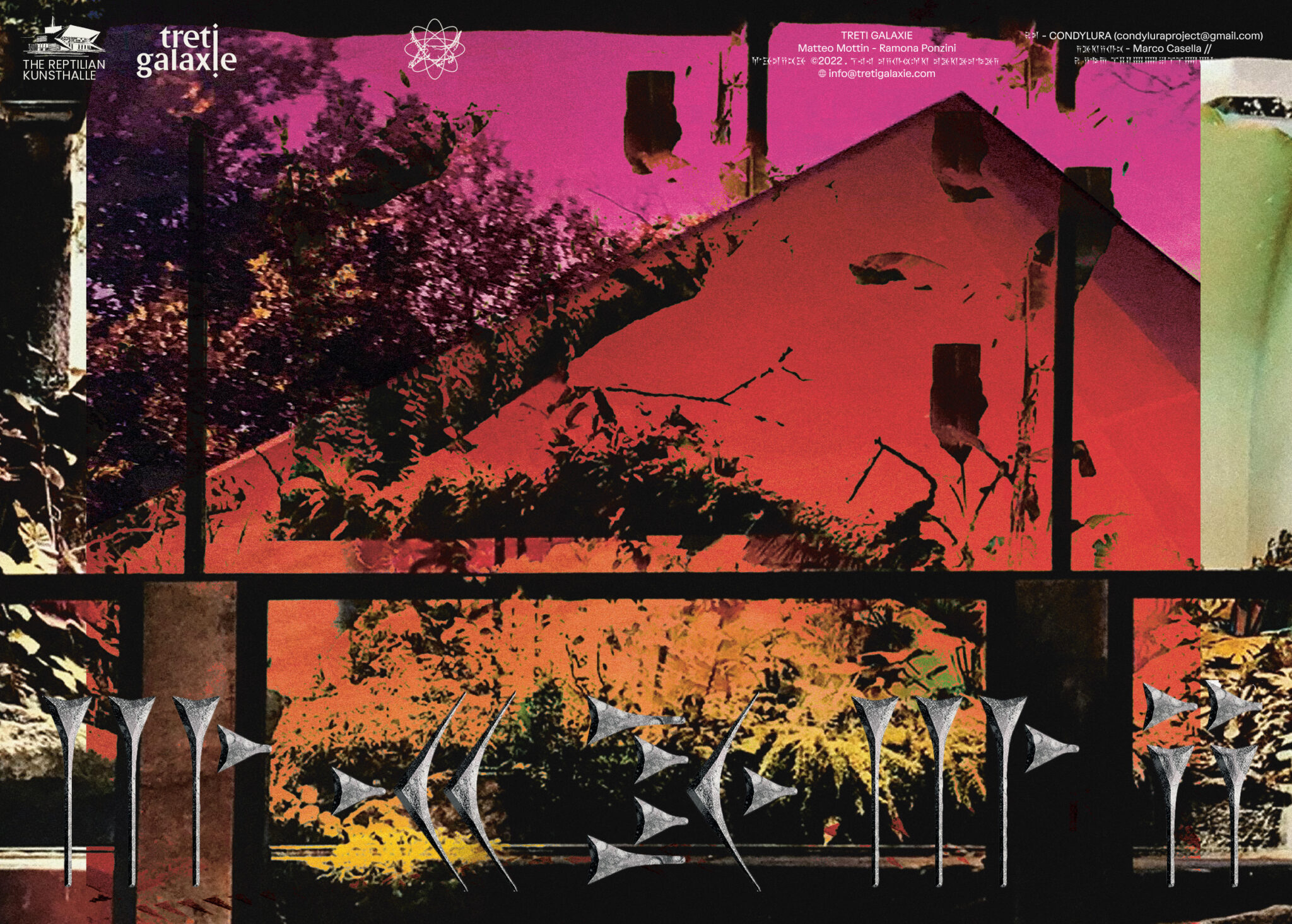
A story of failure and desire in the multiverse for the 6th issue of Condylura
